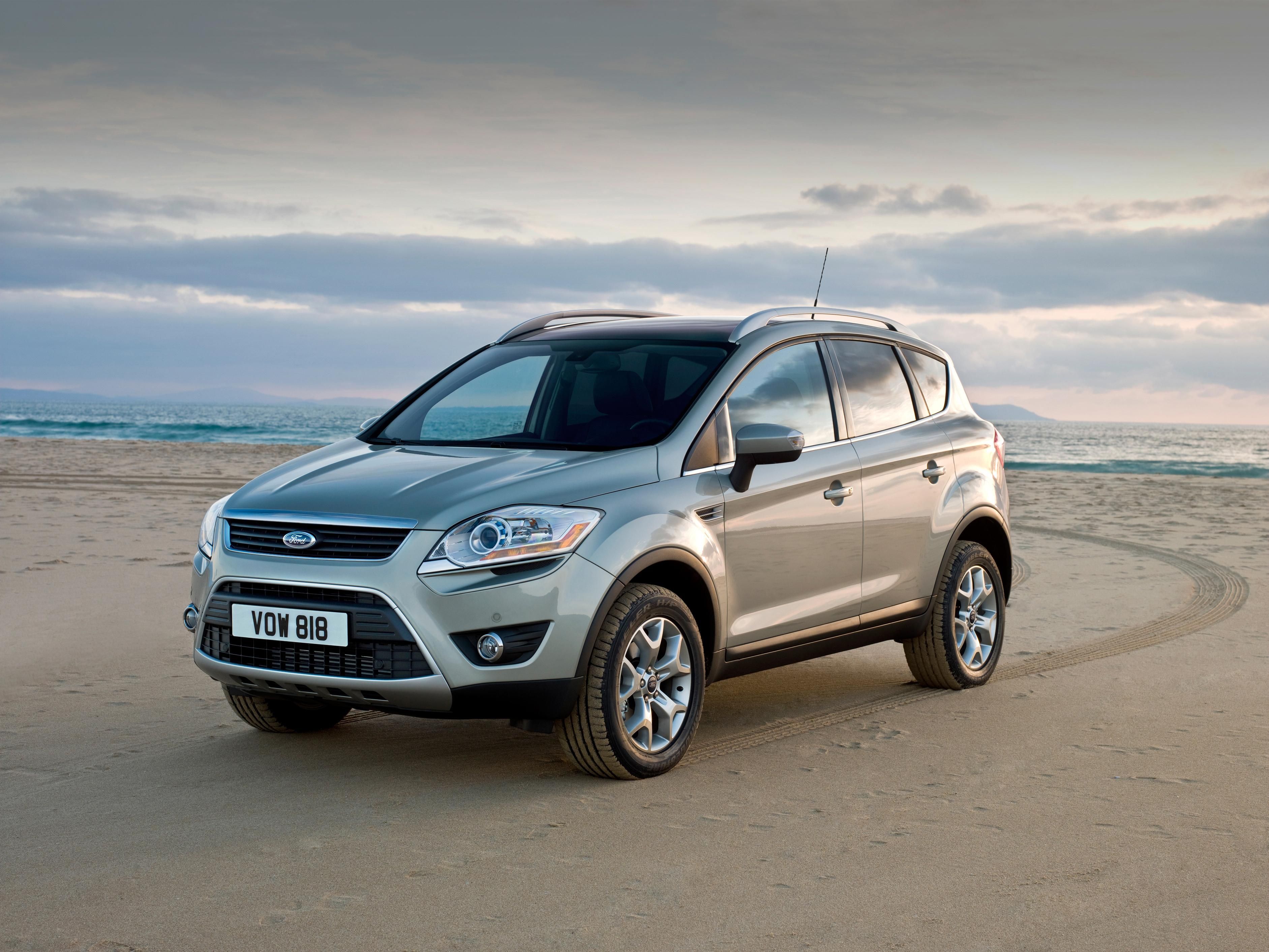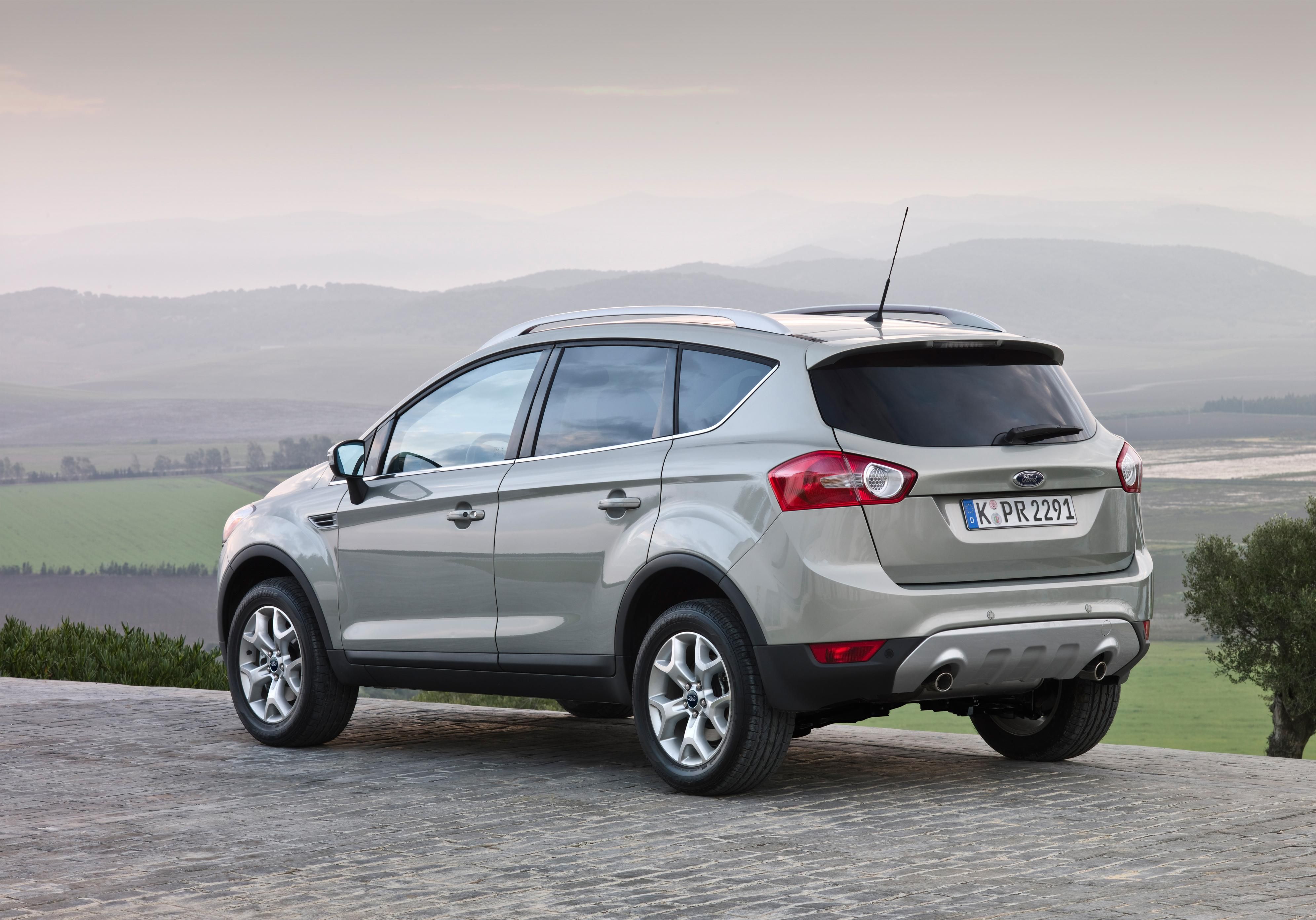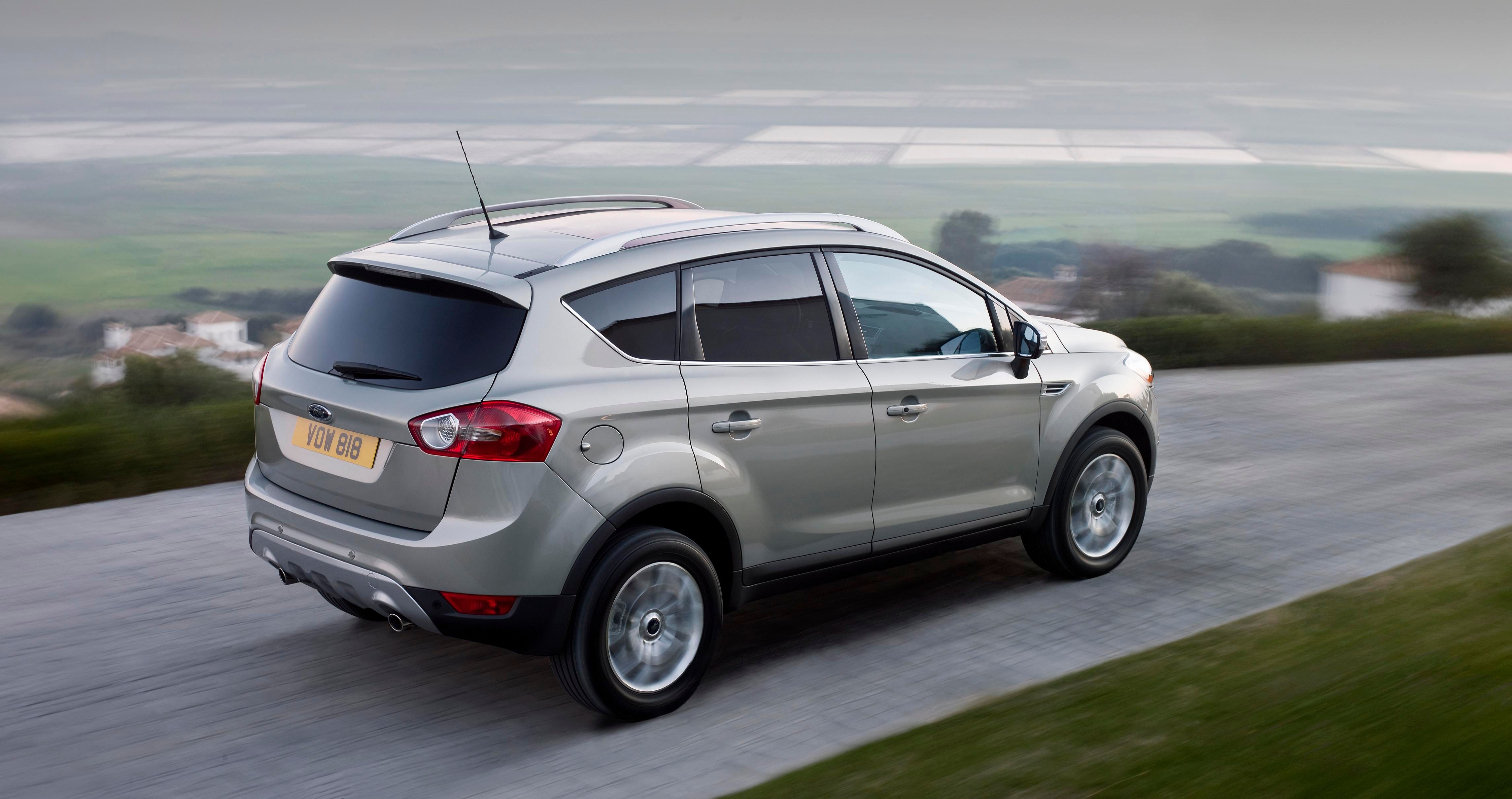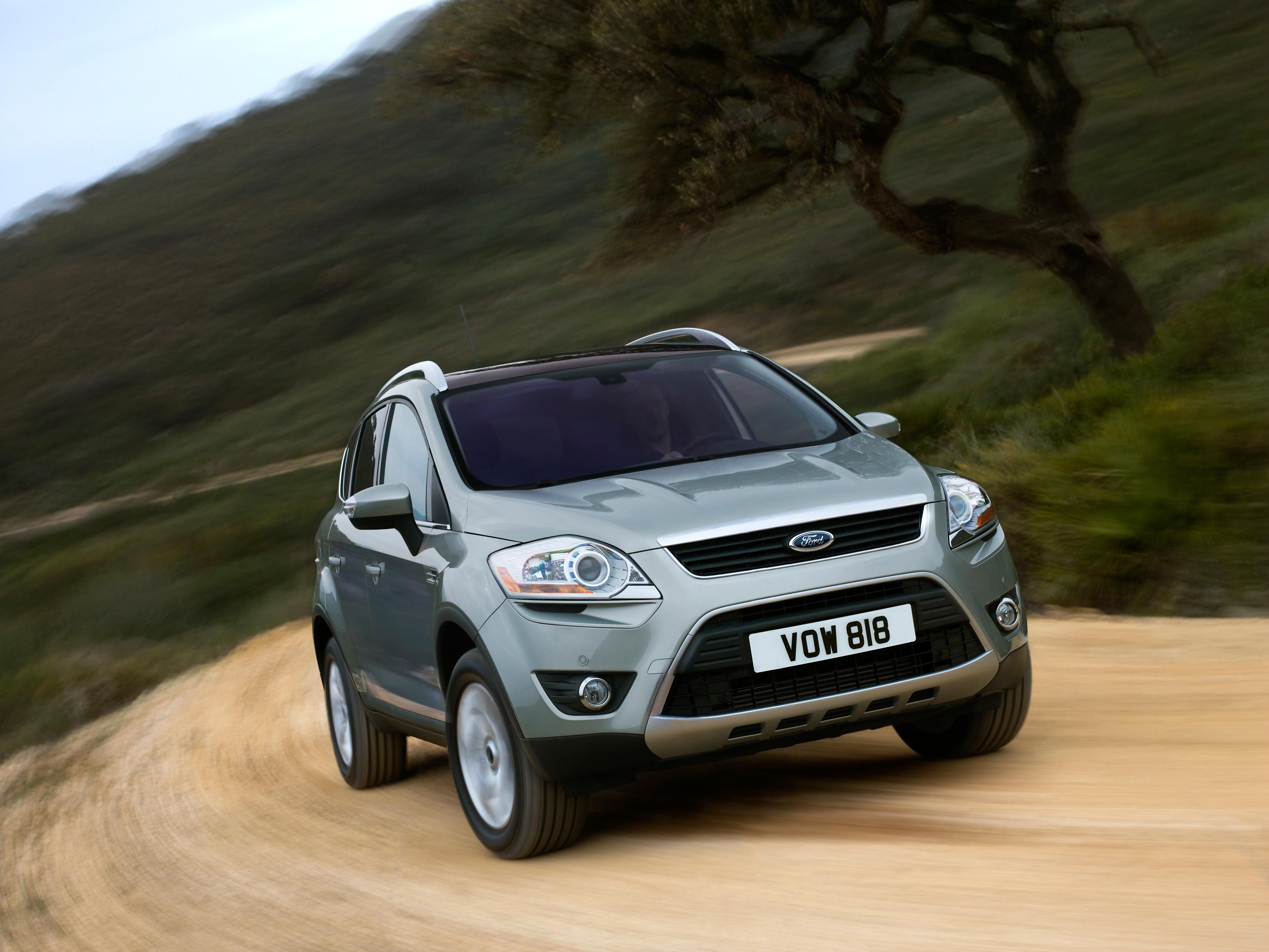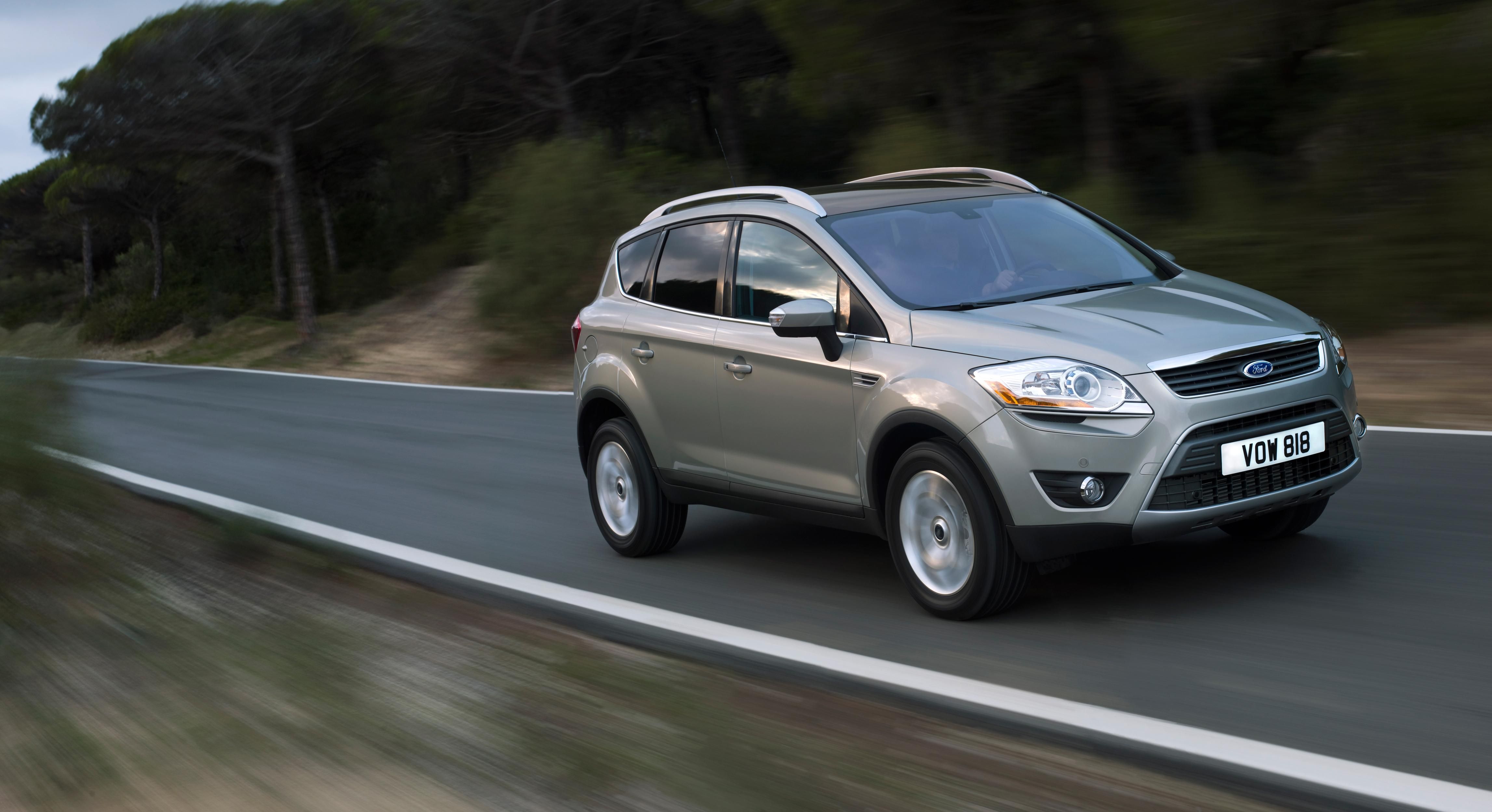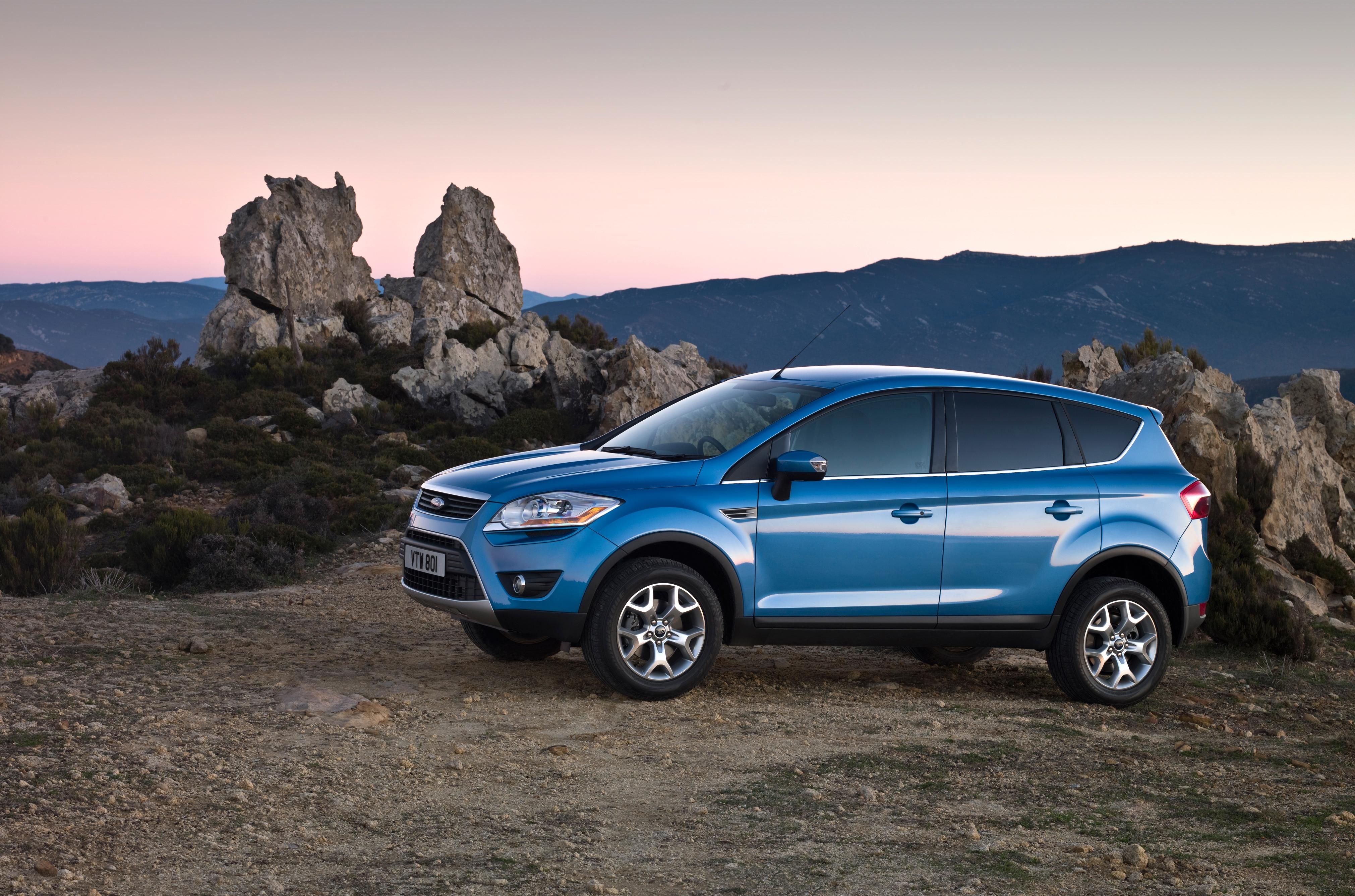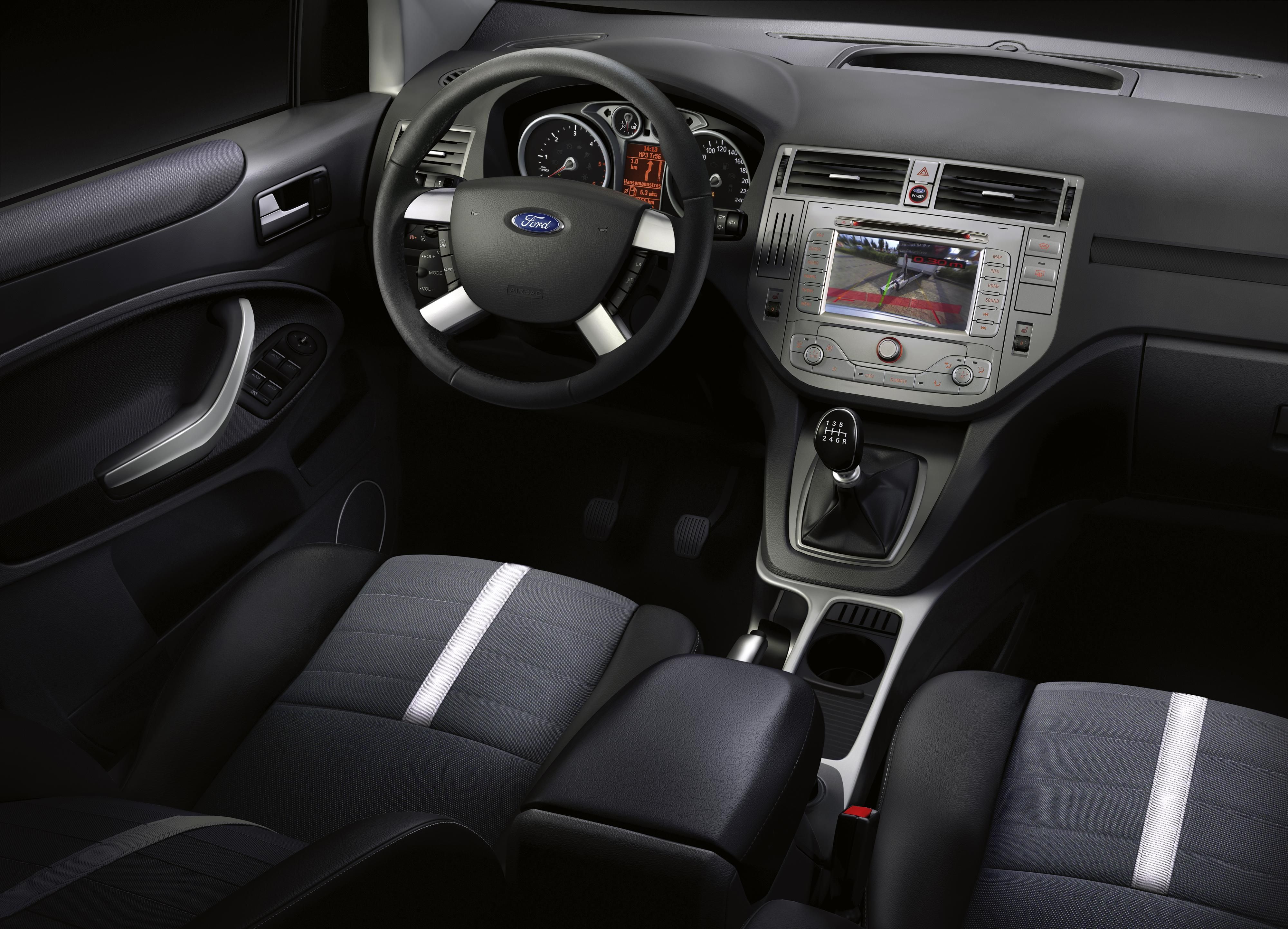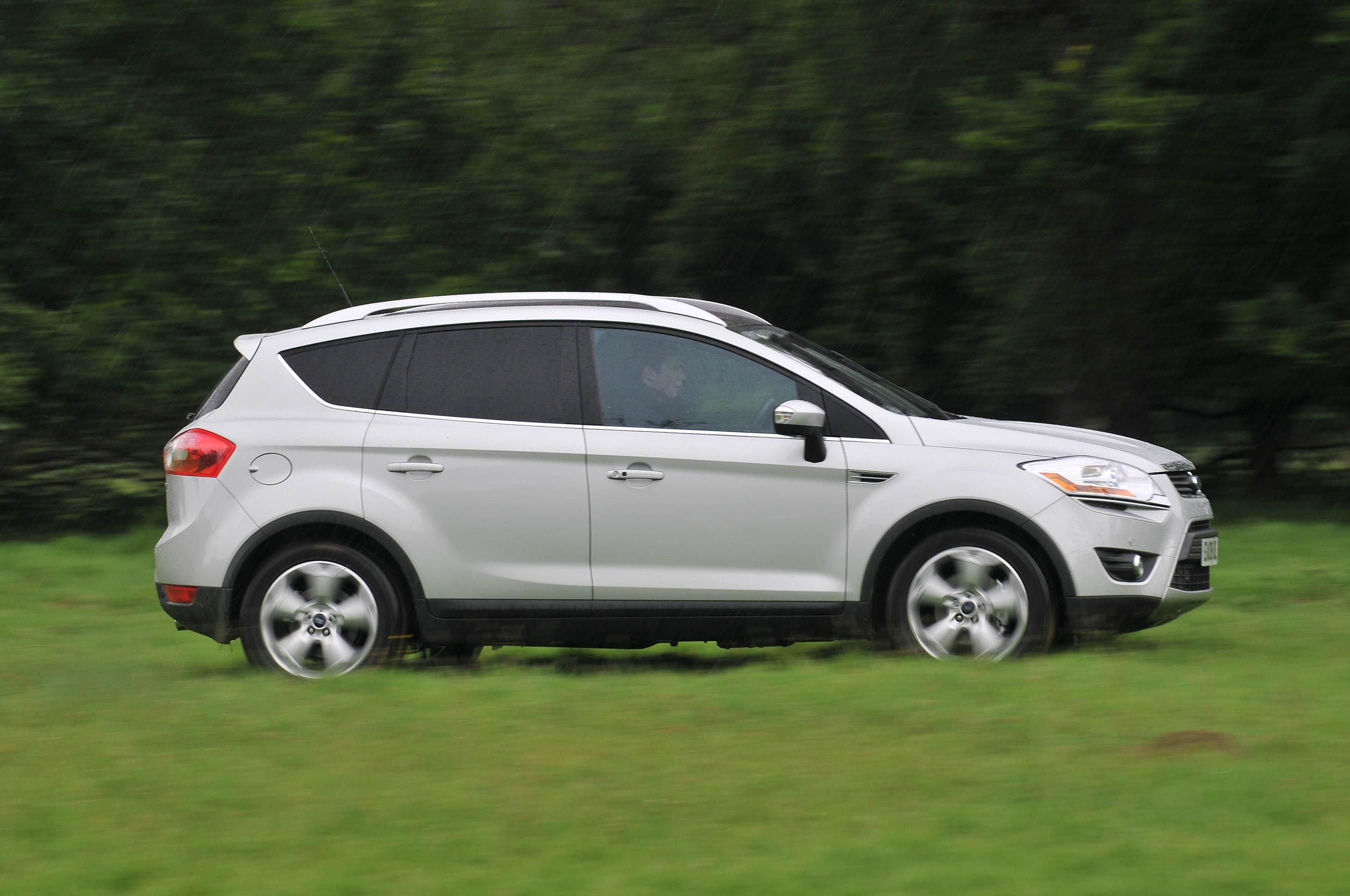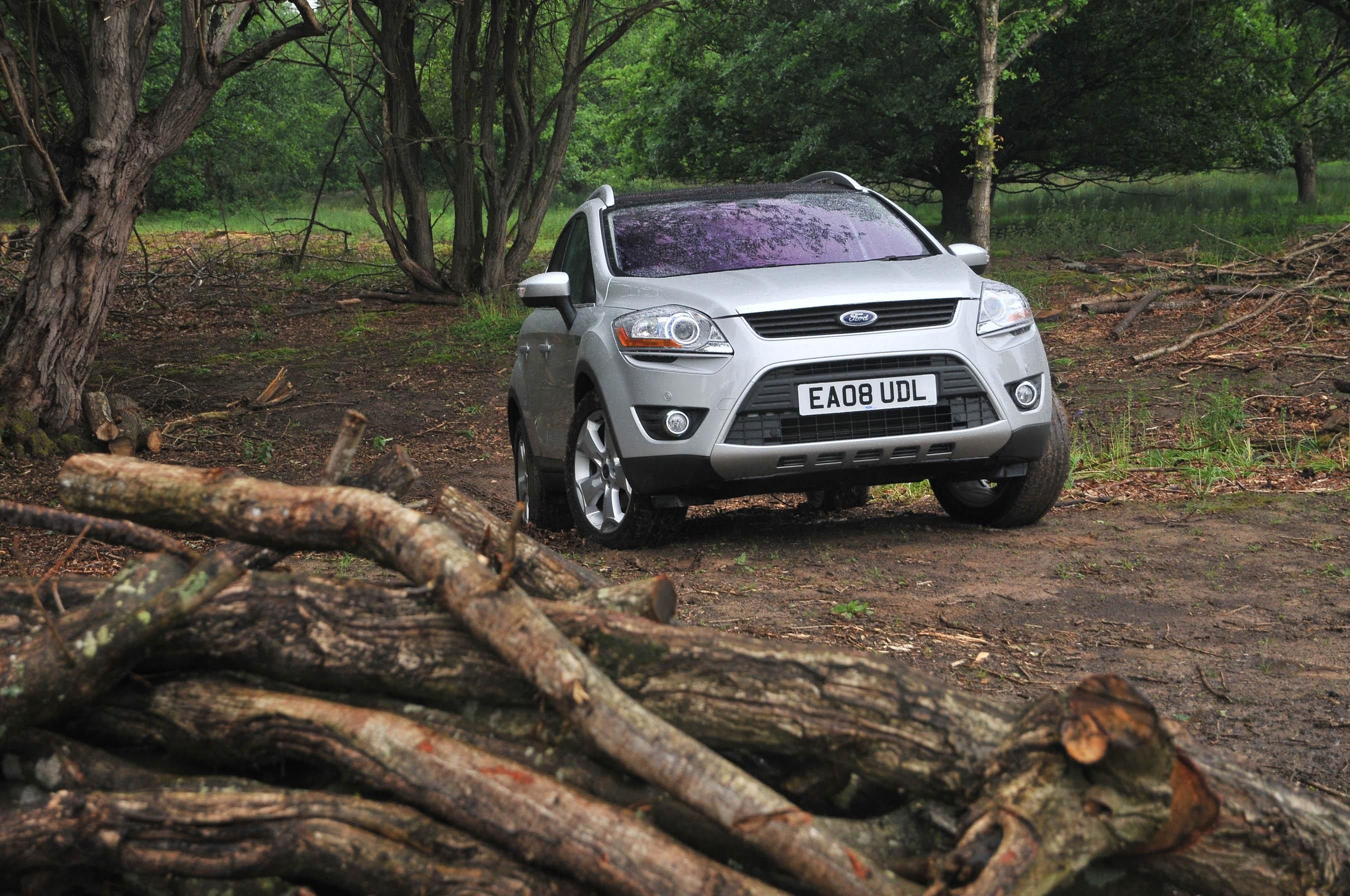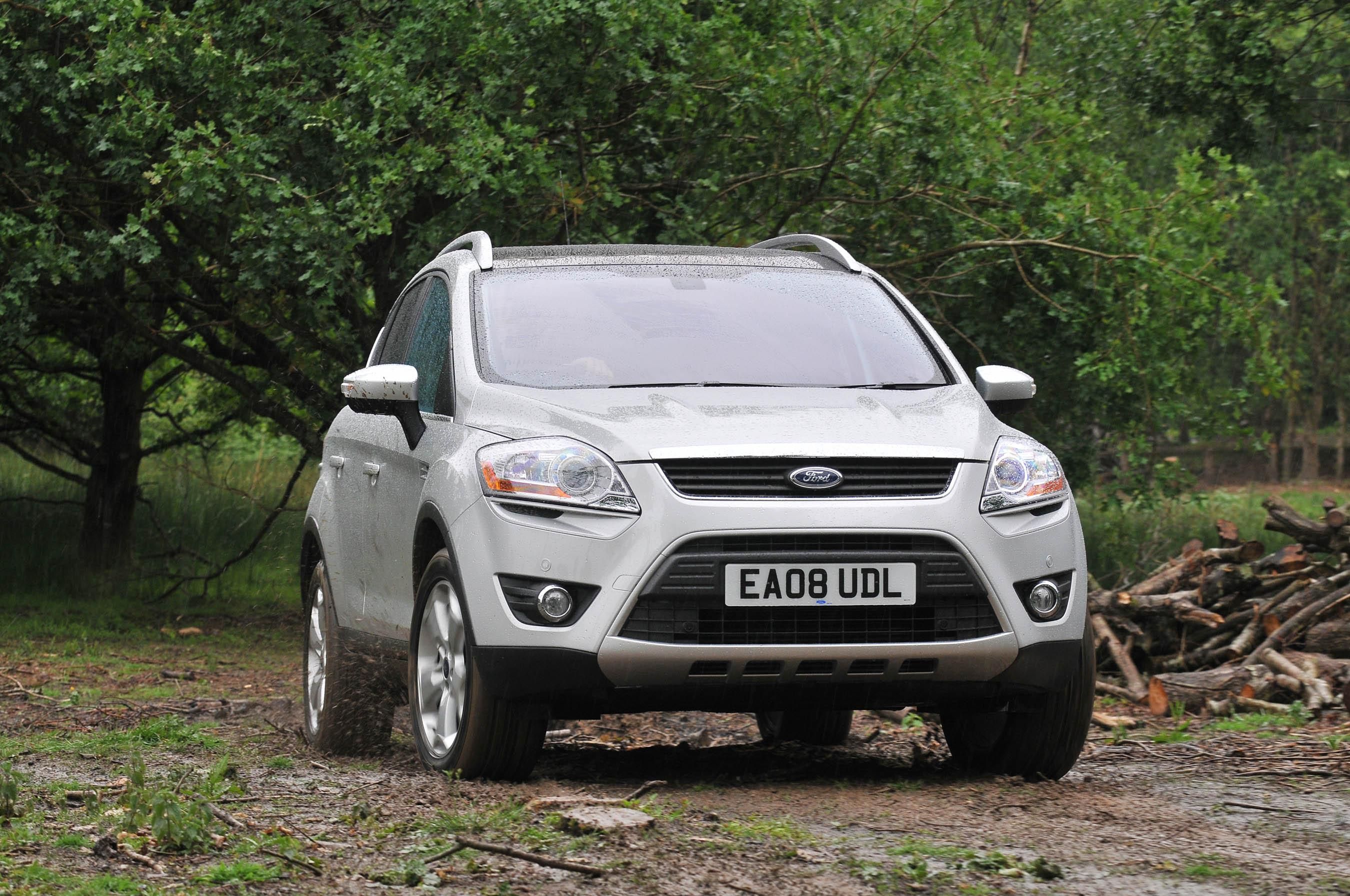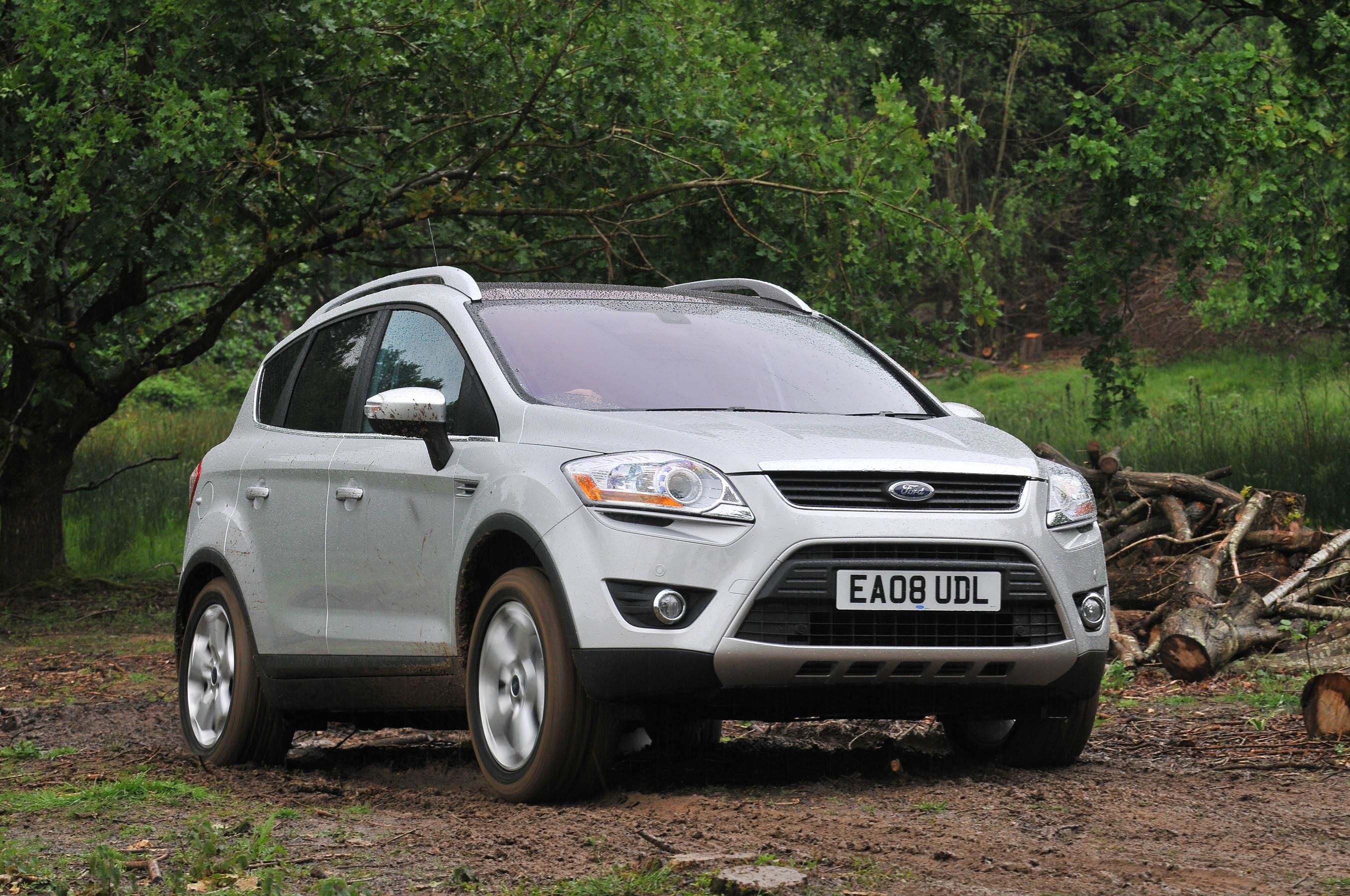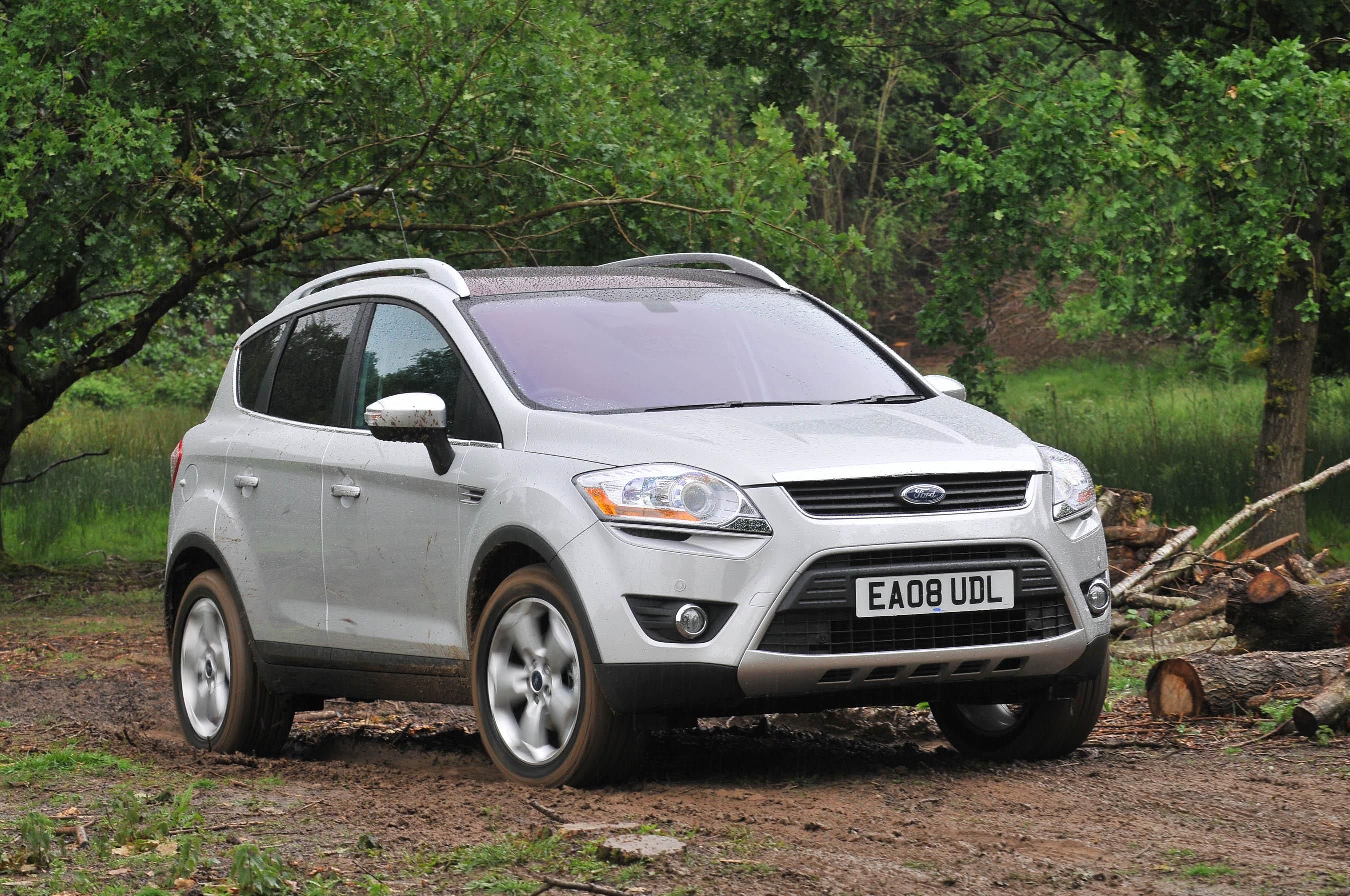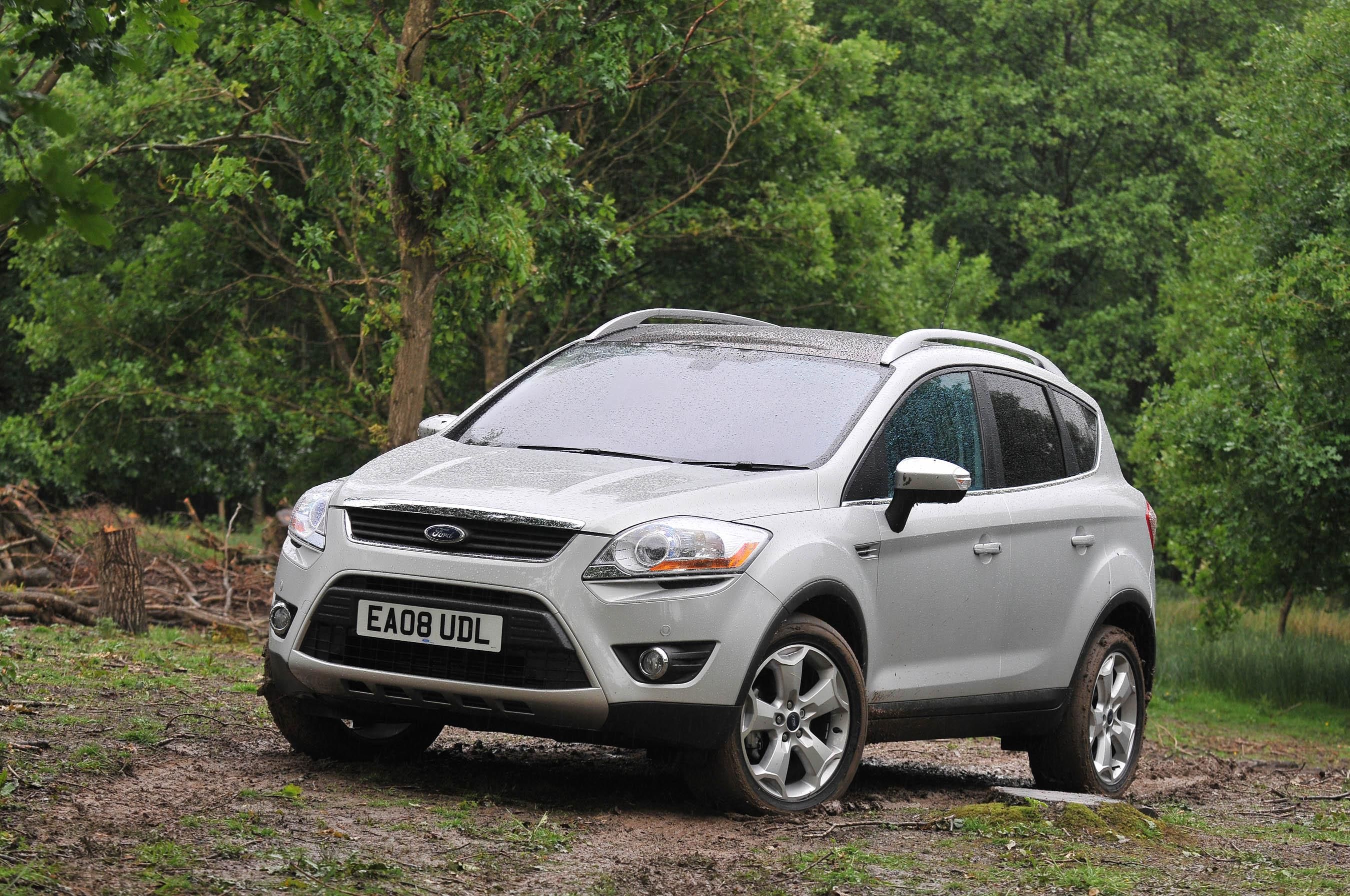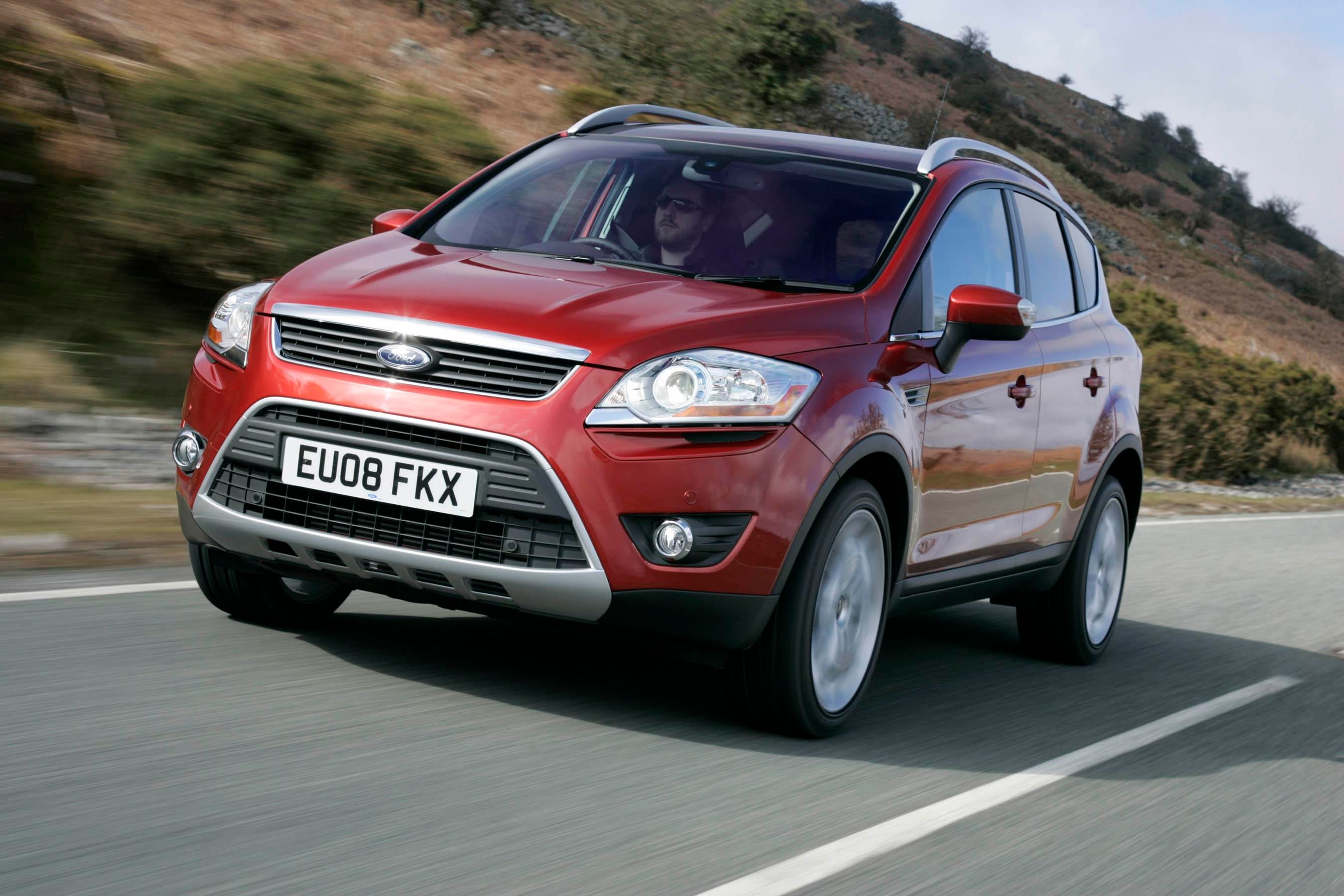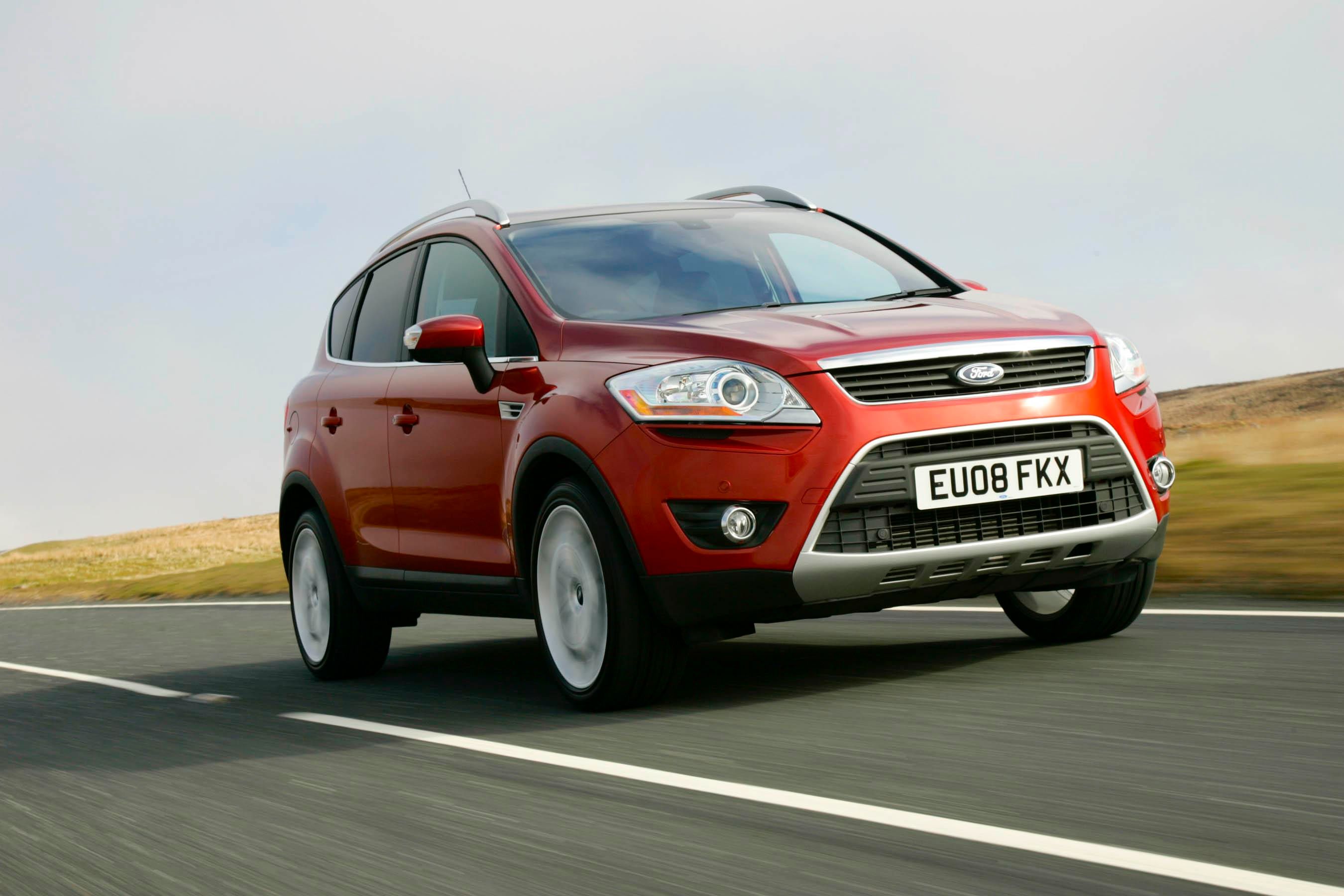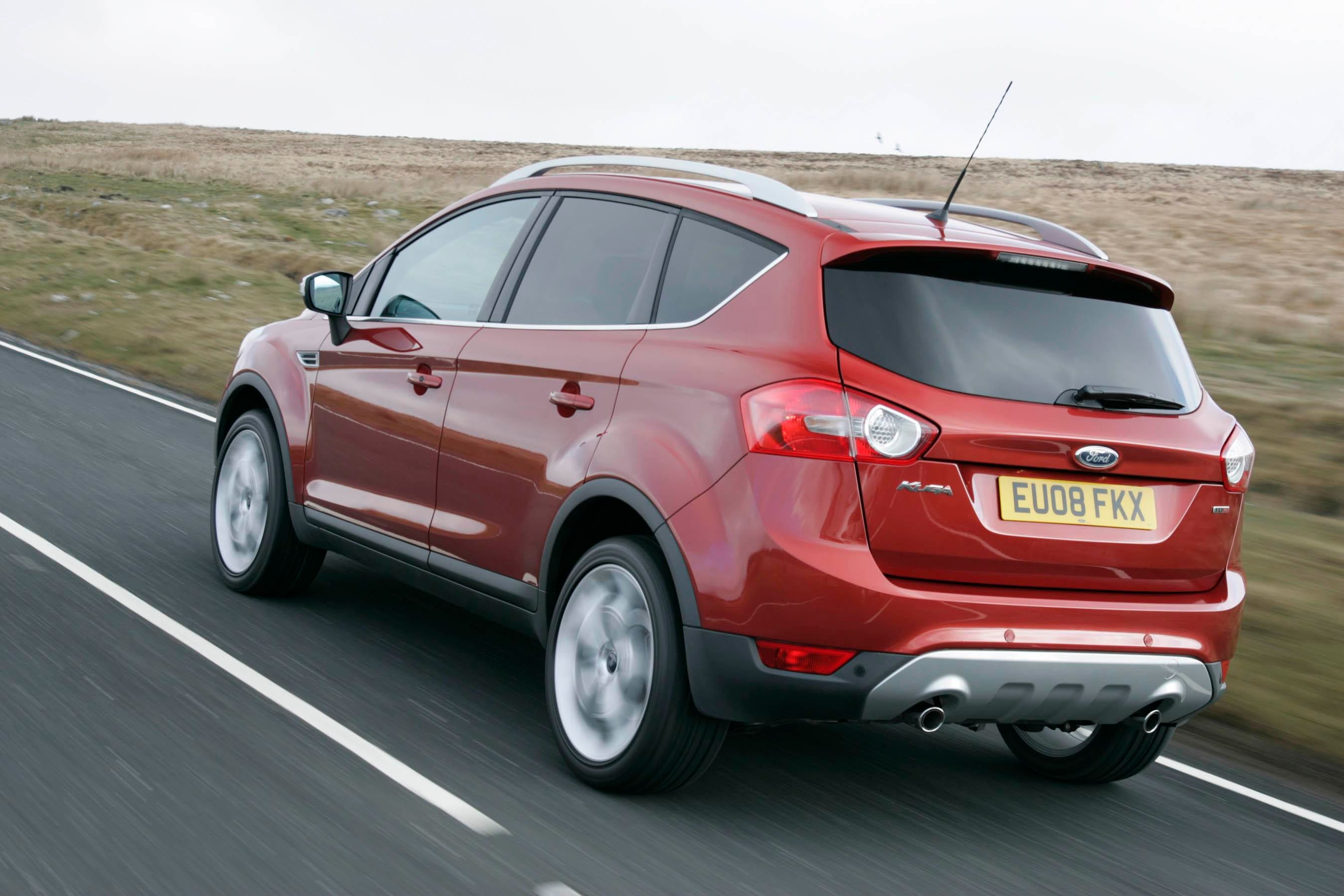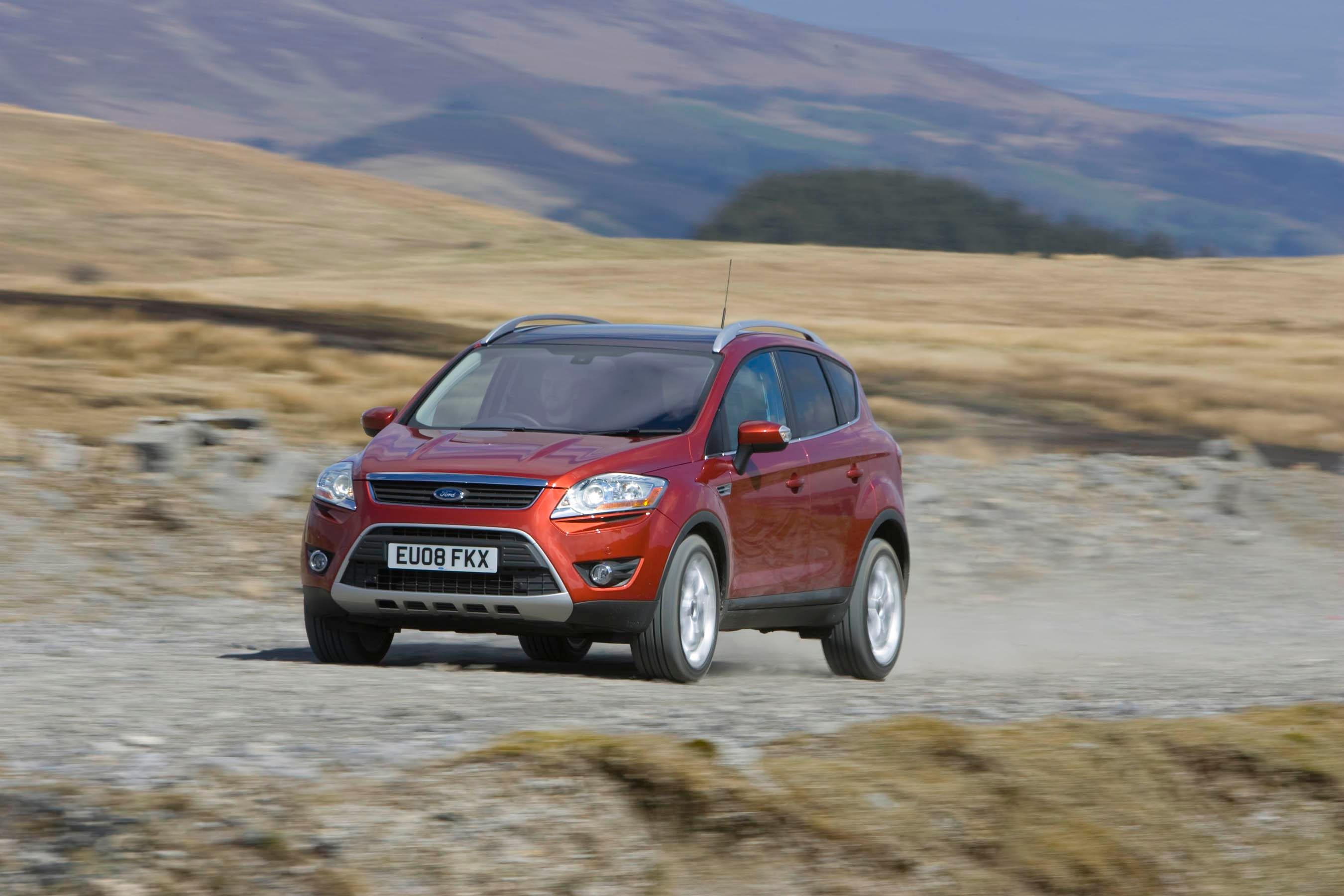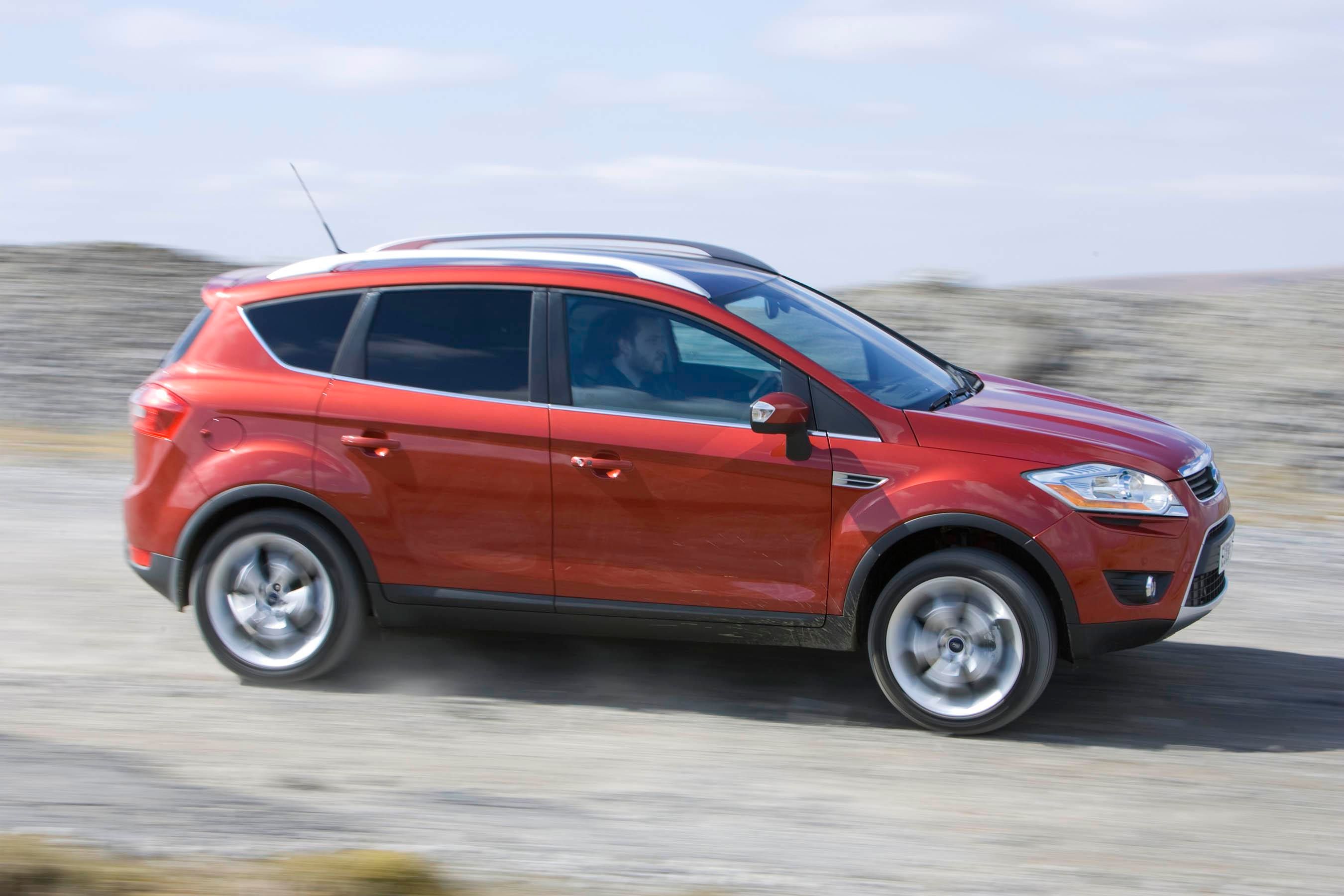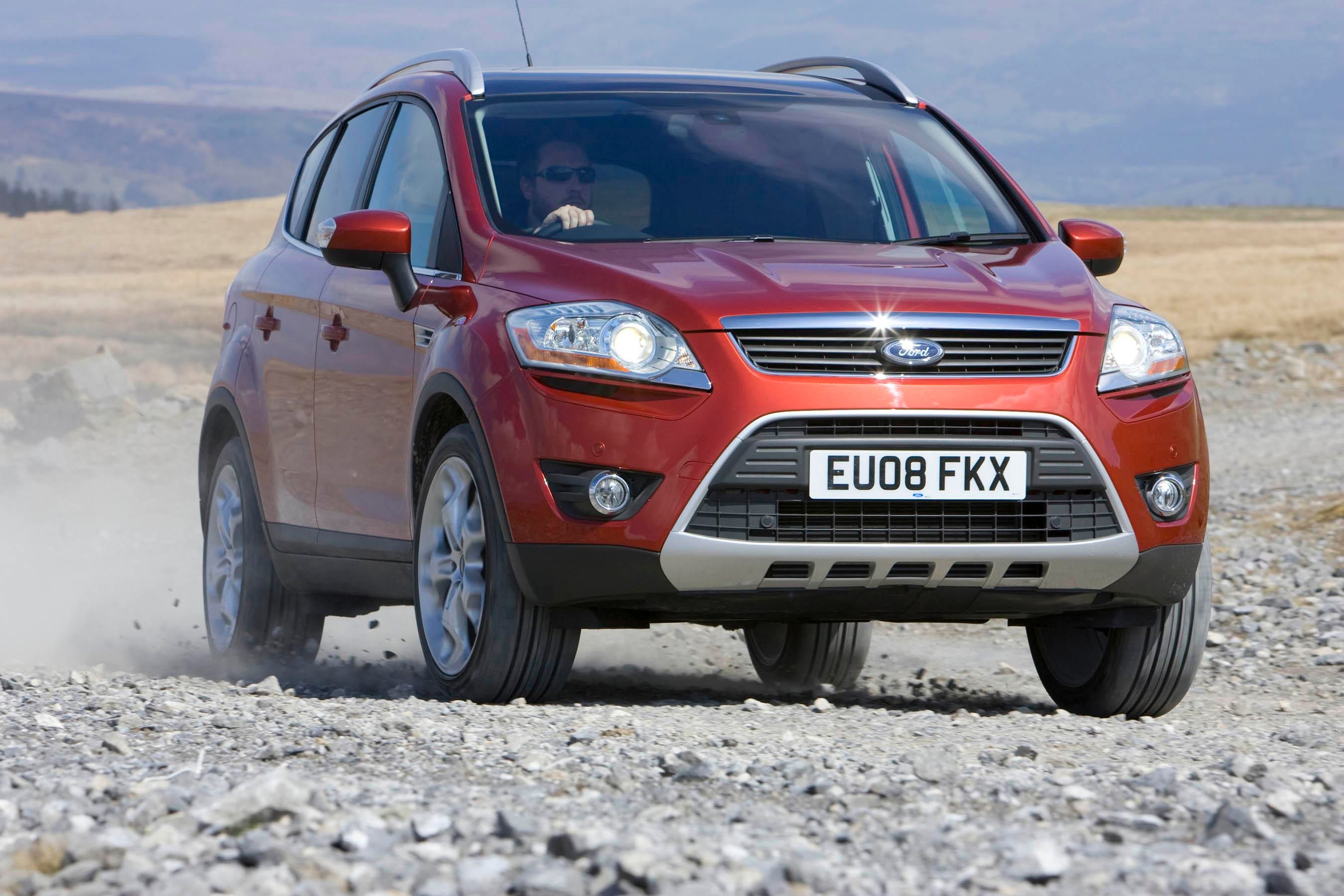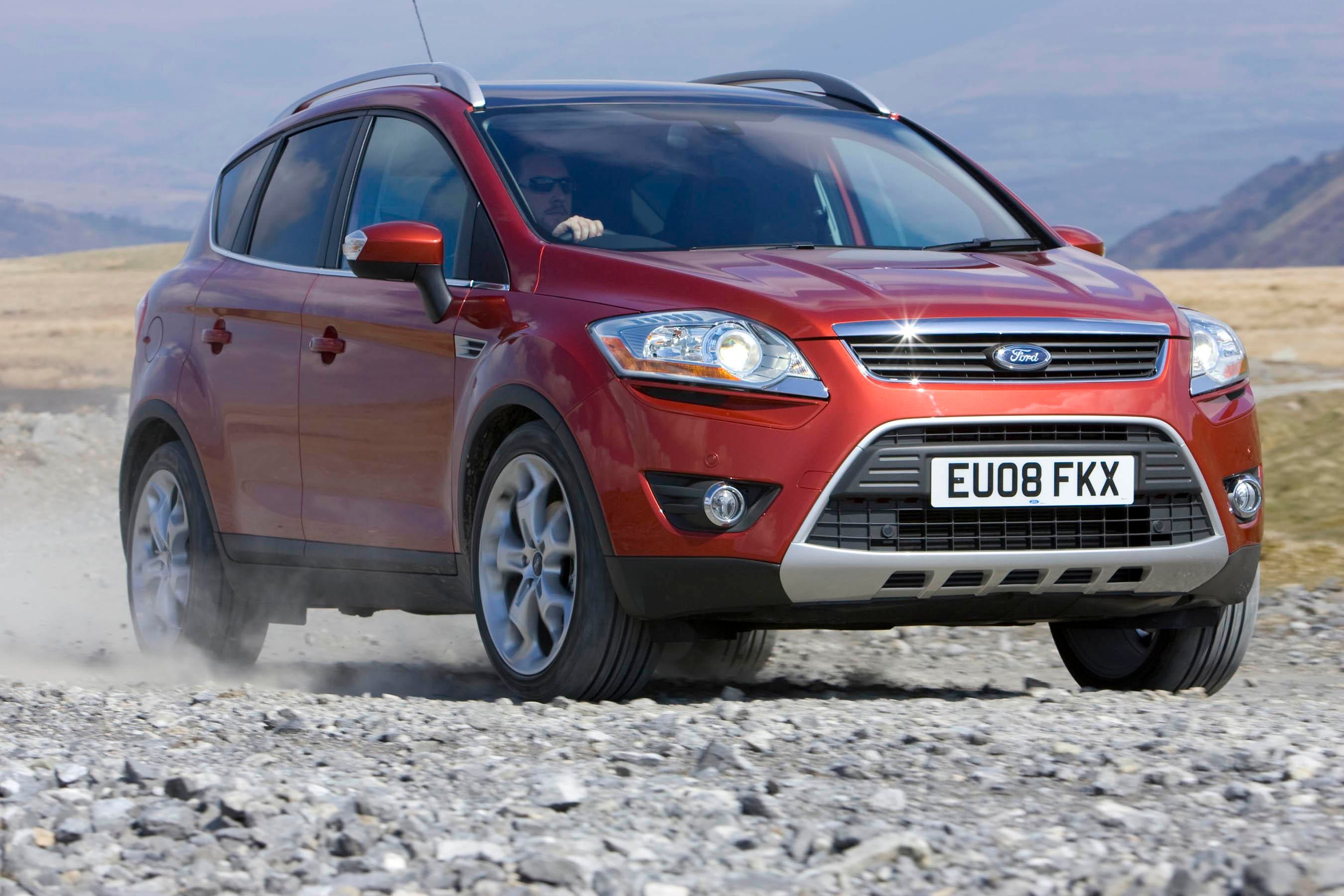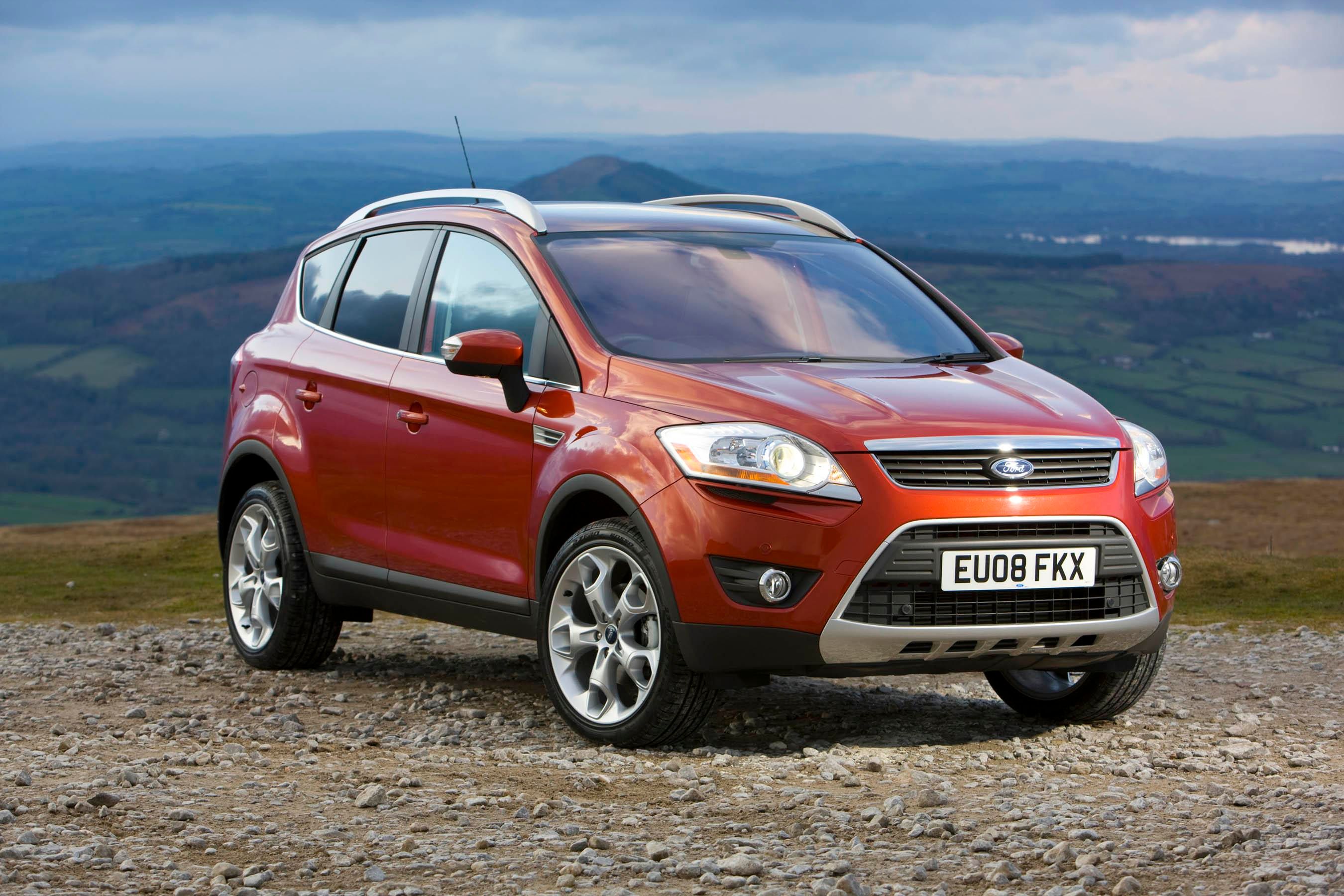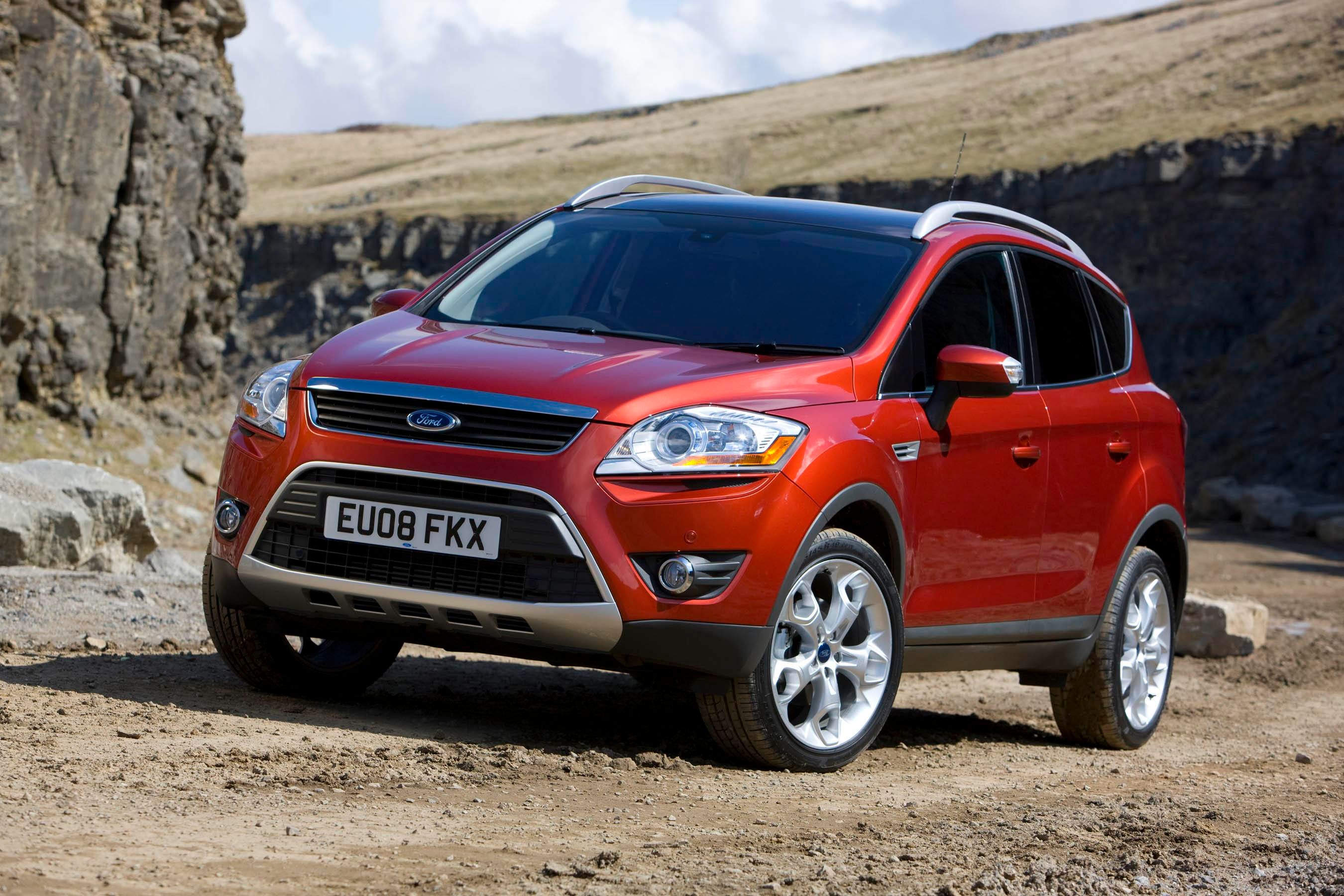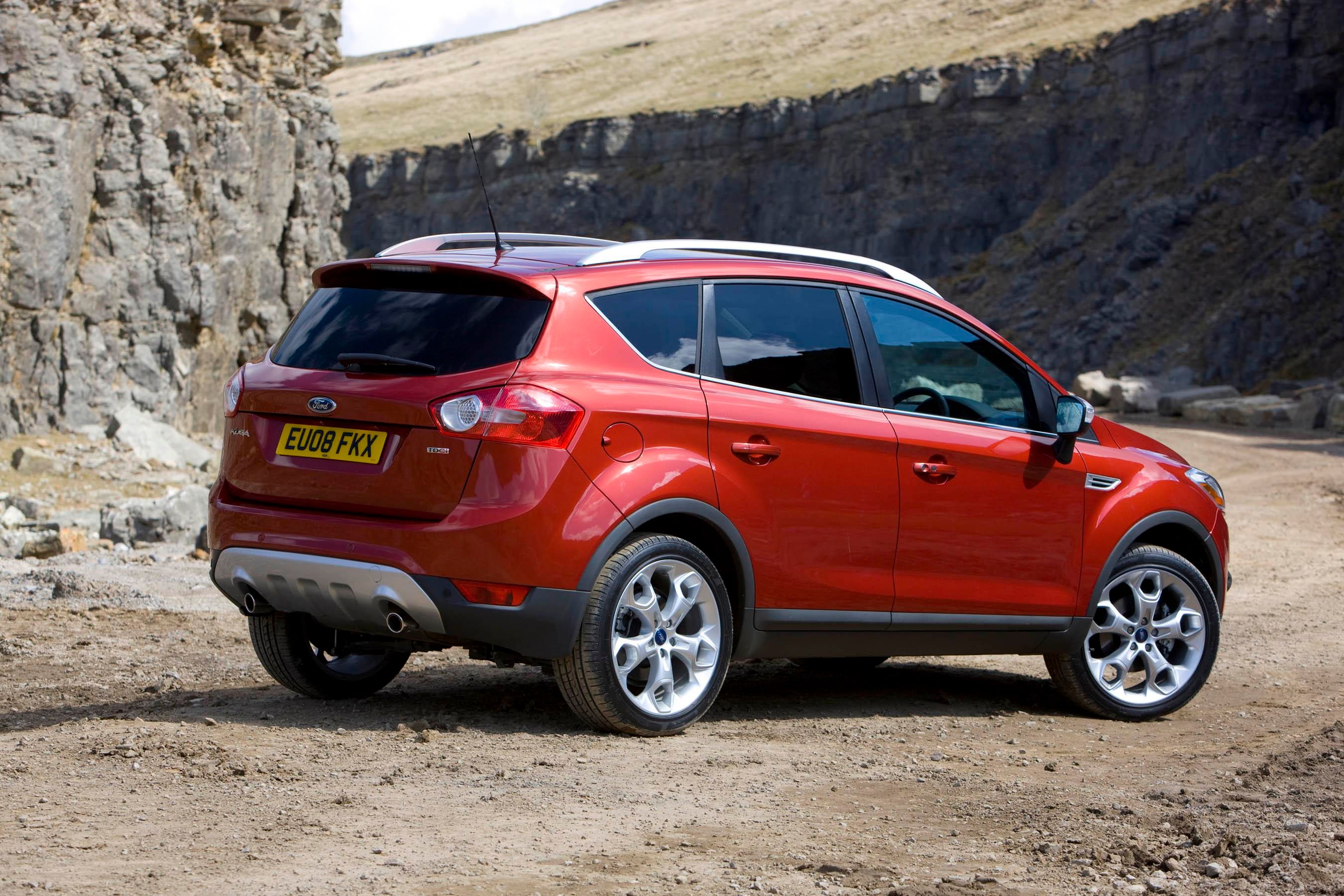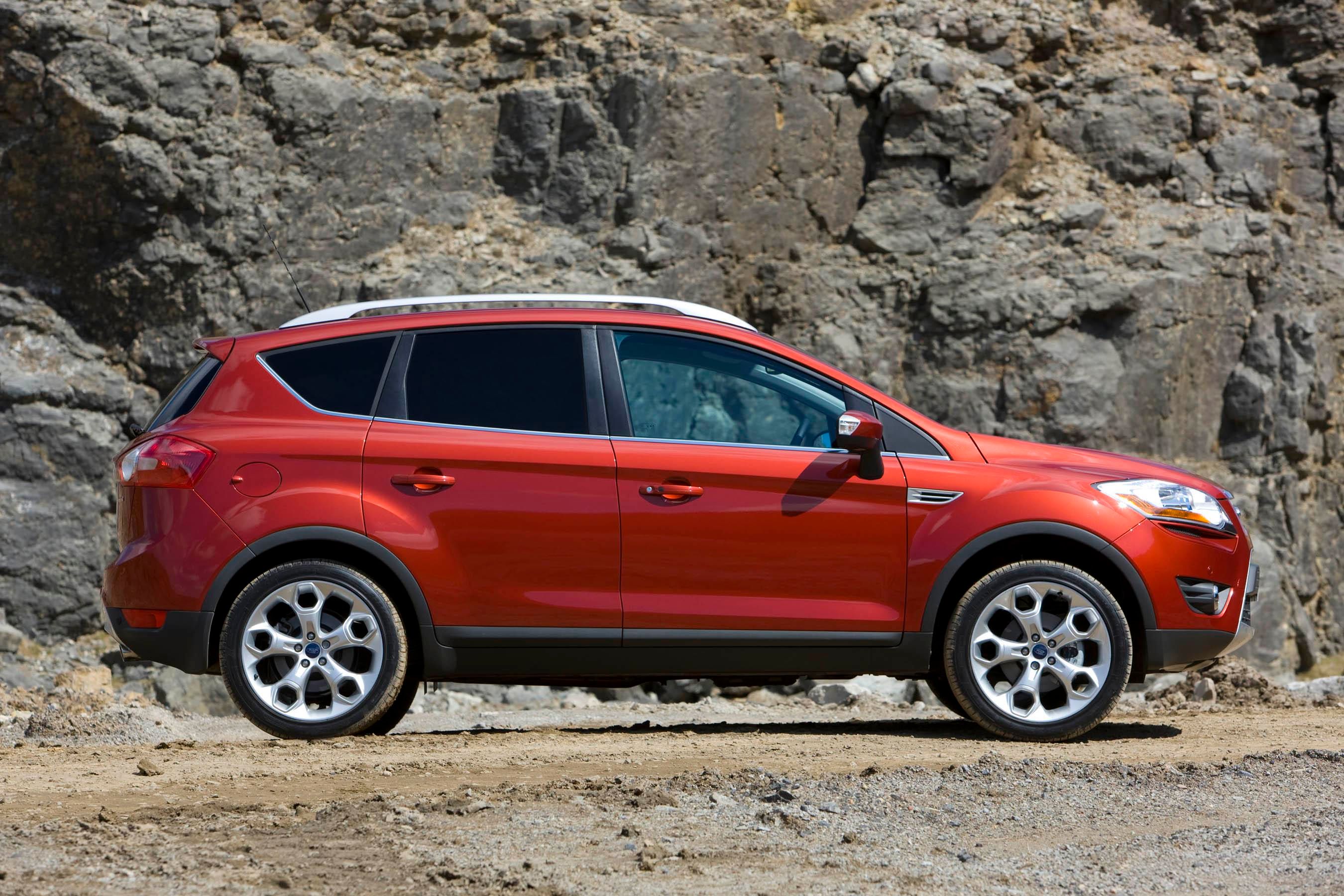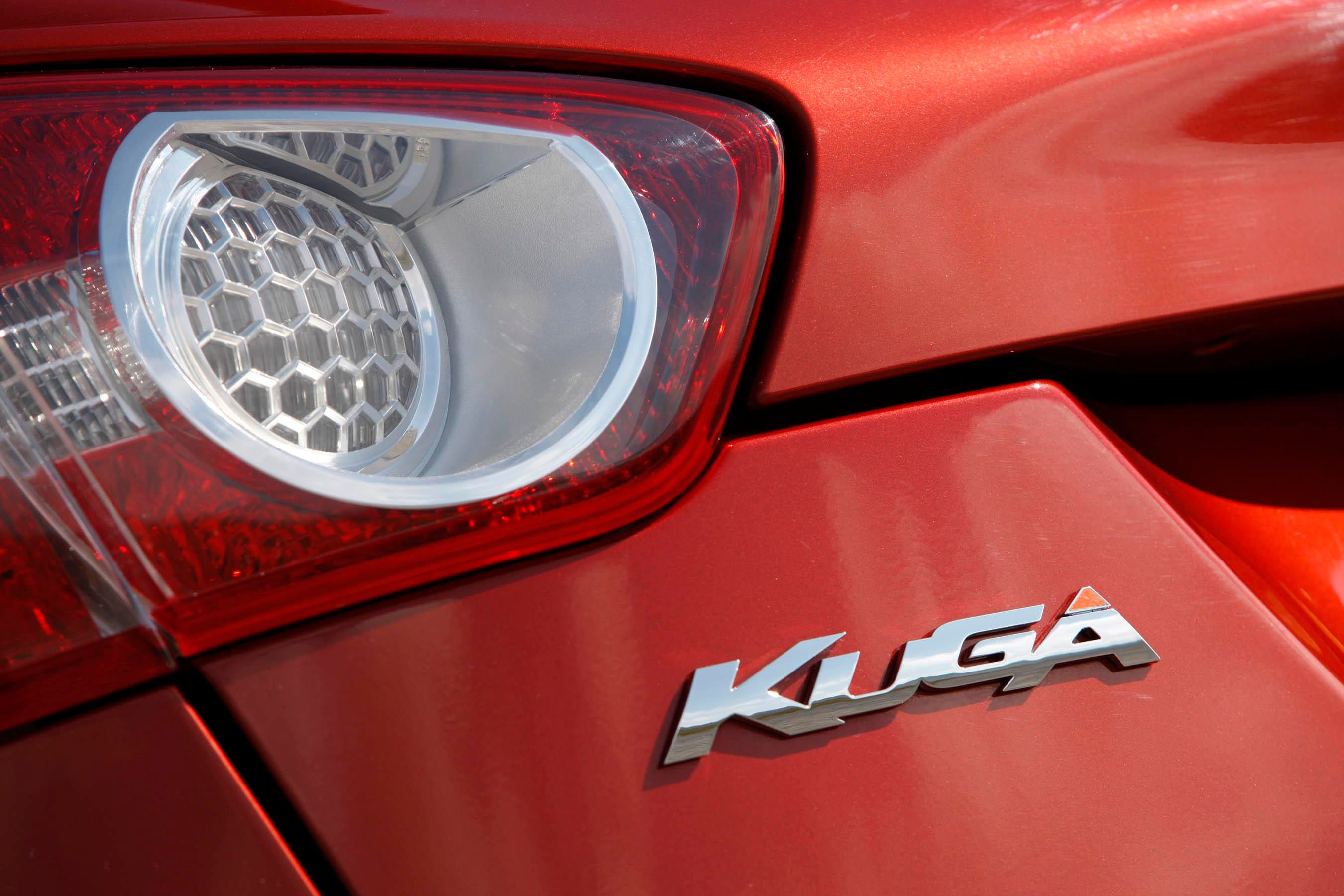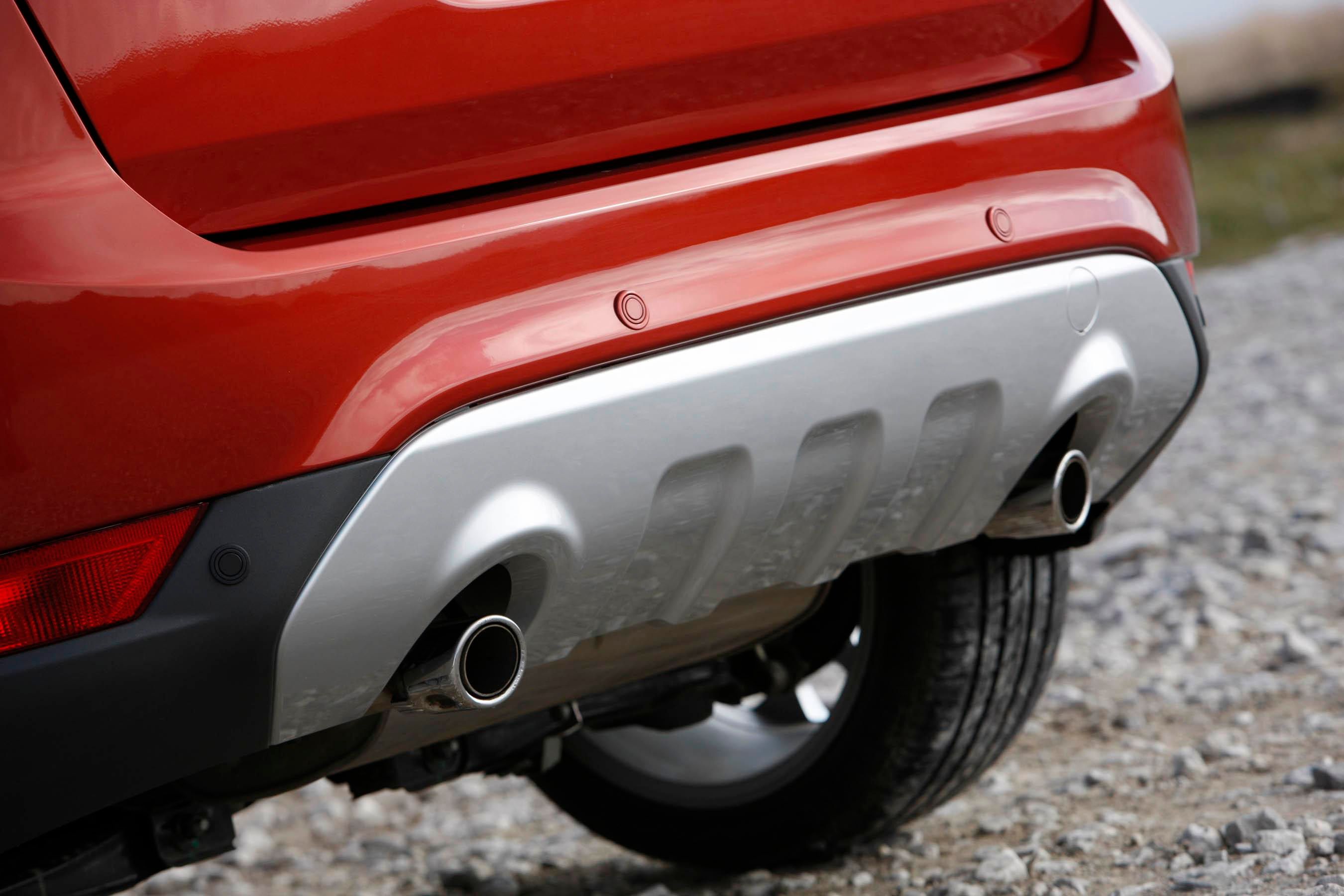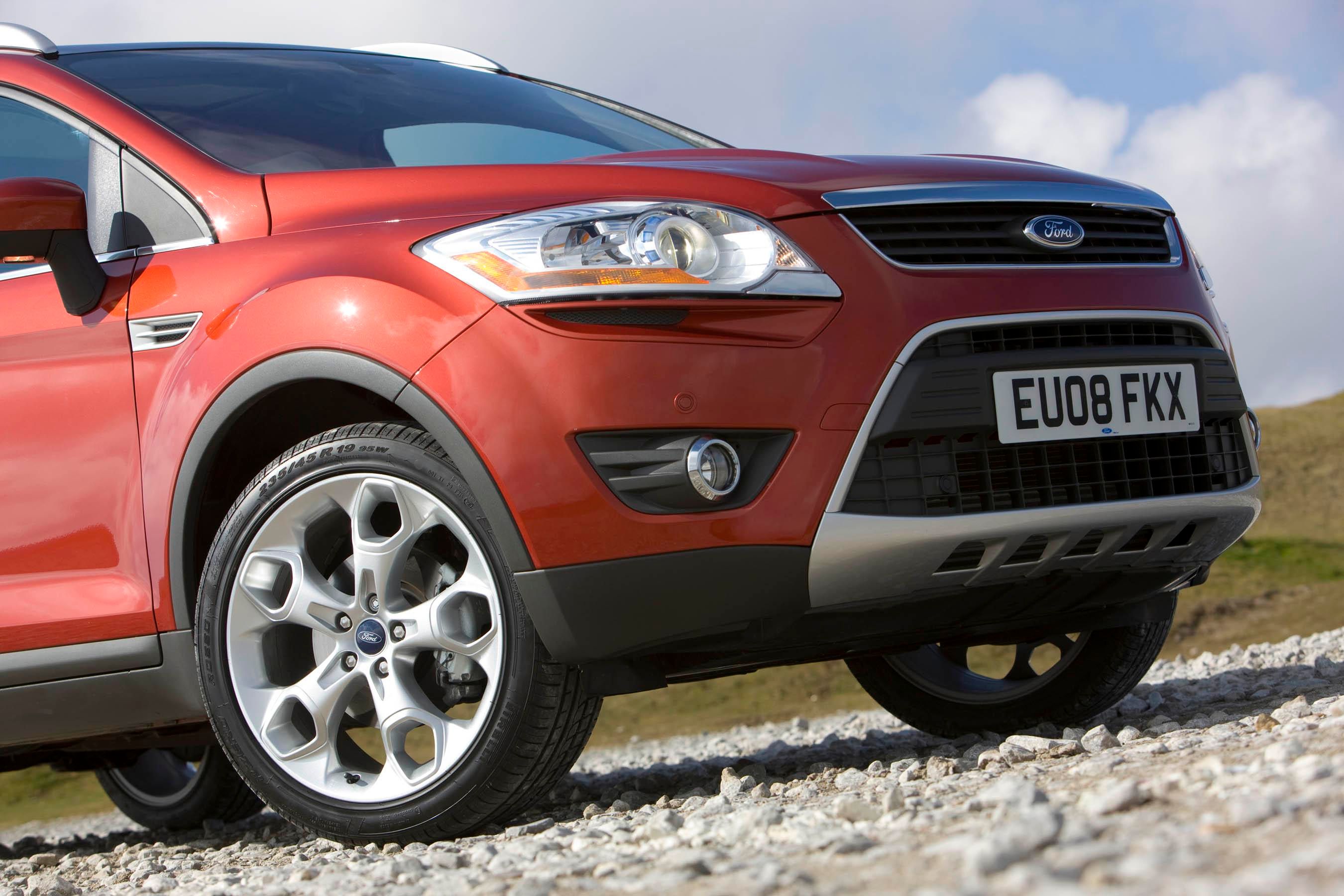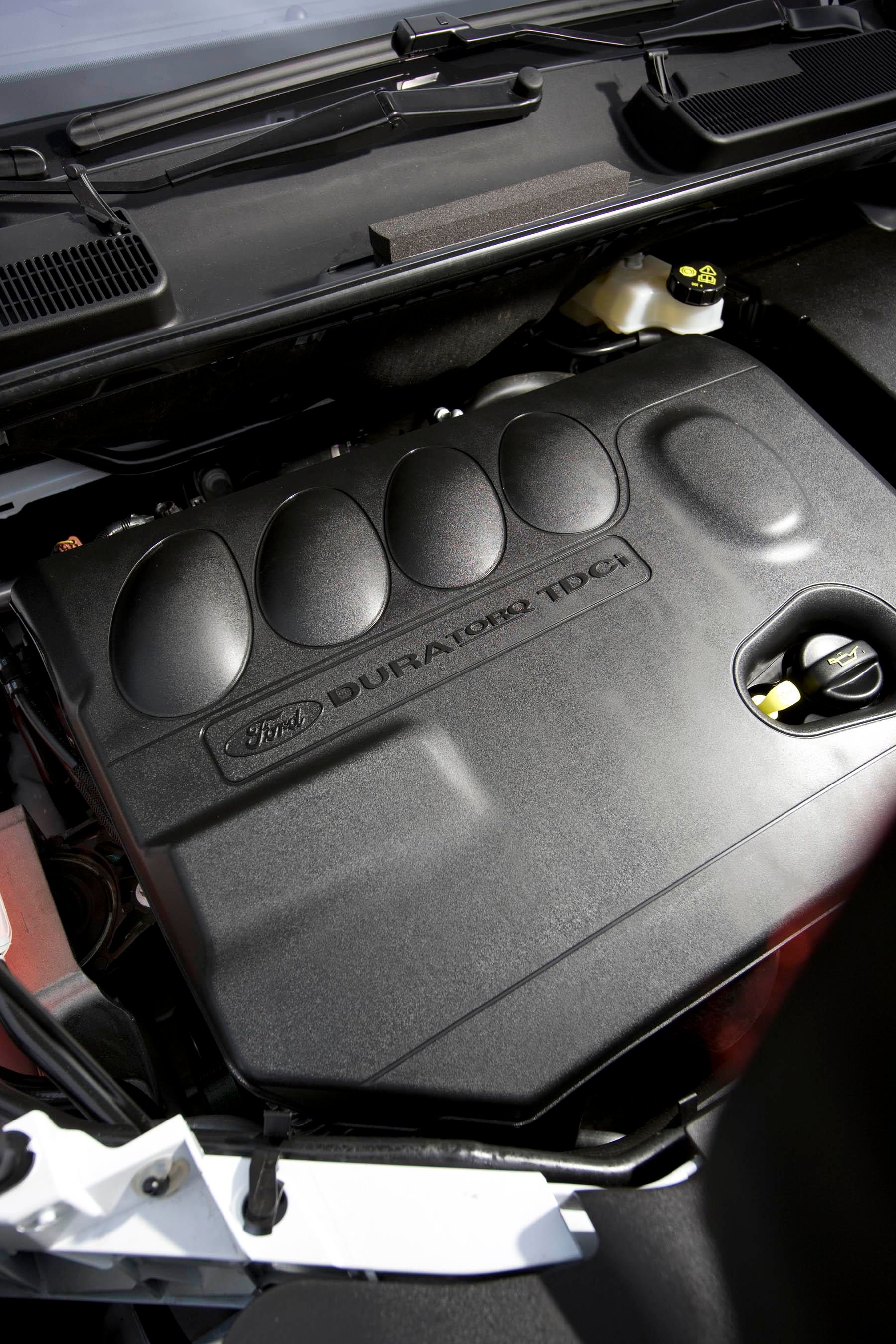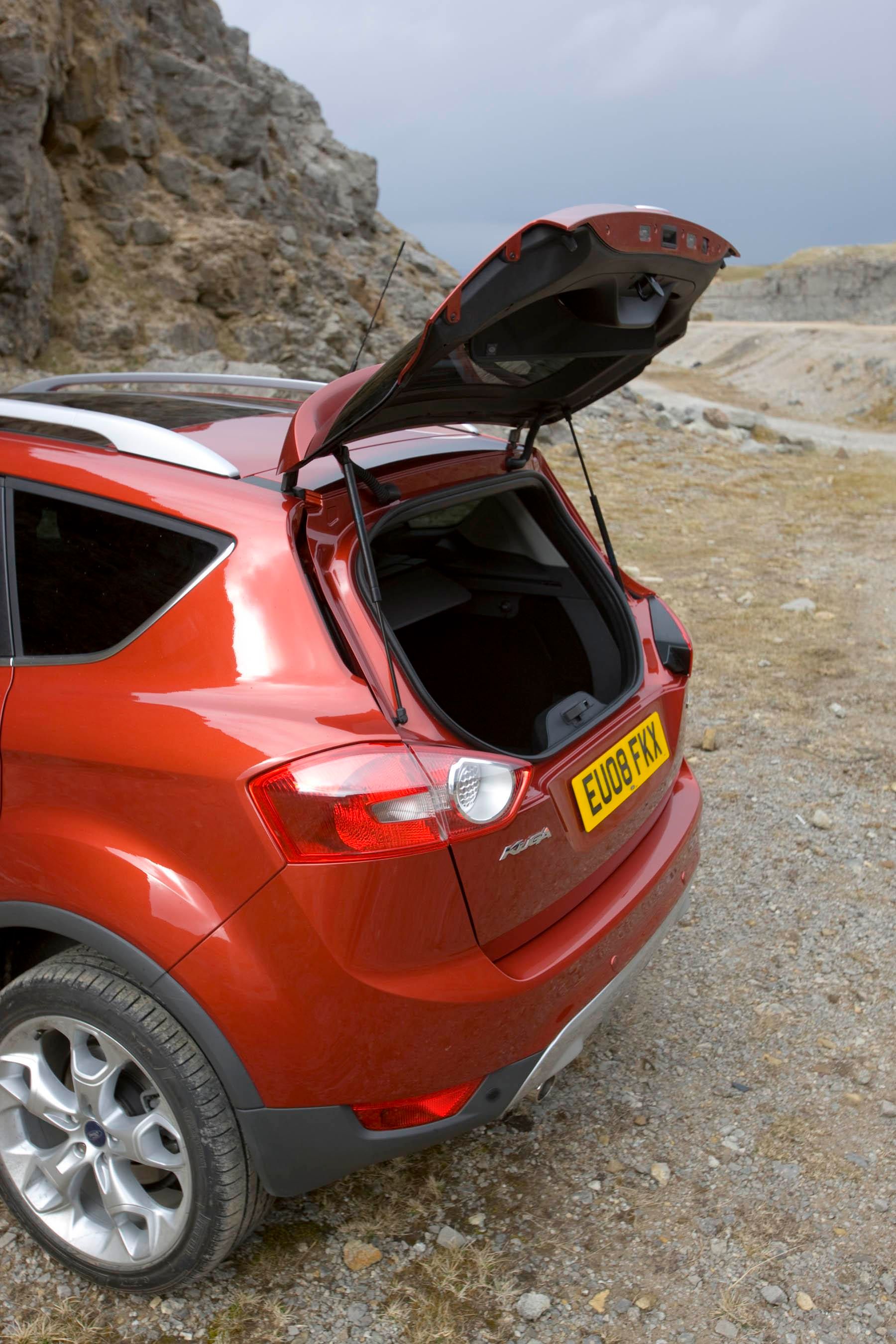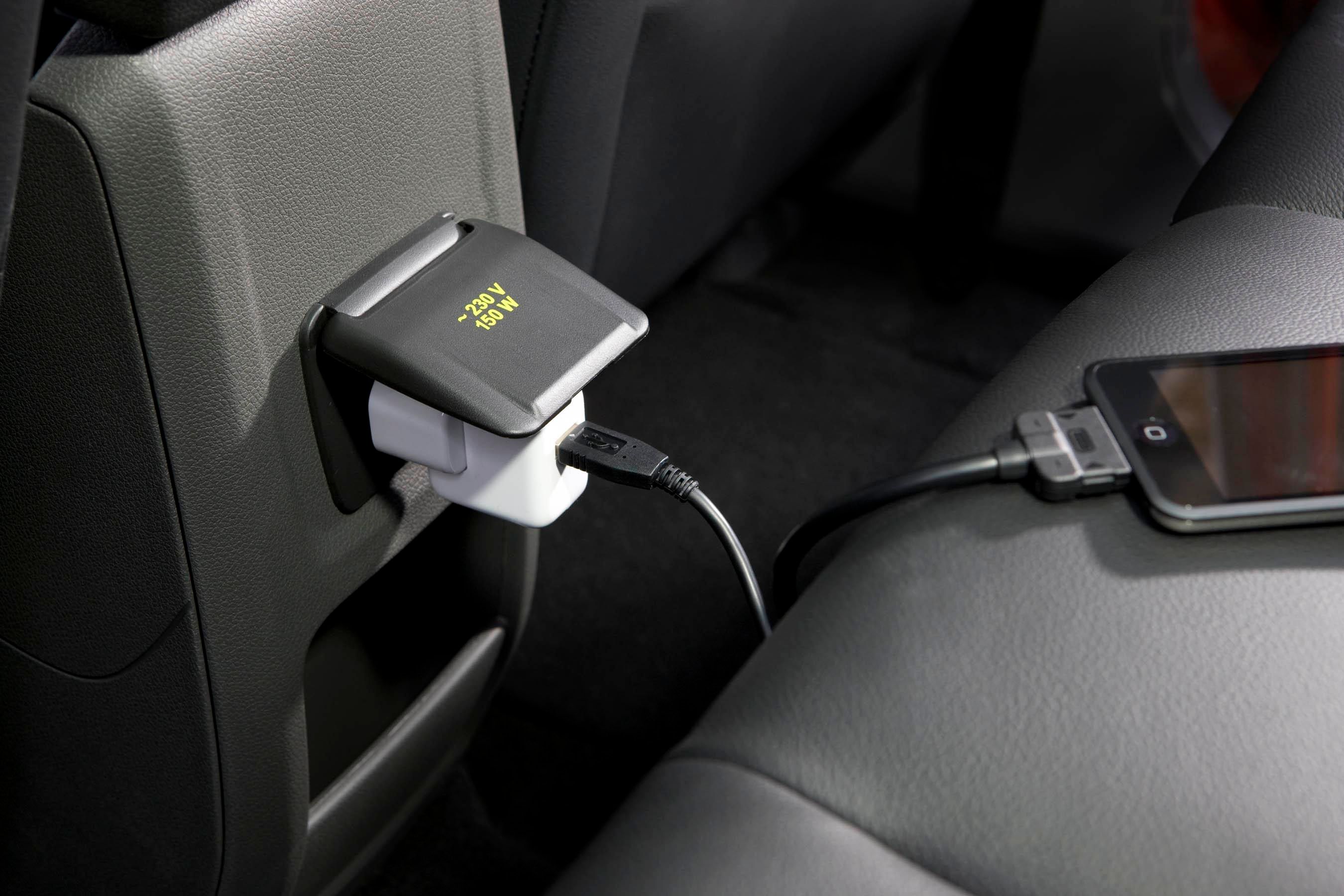Ford Europe will unveil at the Geneva Motor Show the 2009 Kuga, the first ever crossover designed and built by Ford in Europe. Kuga was first presented as the Iosis X Concept in 2006 at the Paris Motor Show and then as a prototype version at the 2007 Frankfurt Motor Show.
The new Ford Kuga is based unashamedly on Ford's acclaimed C-car architecture – well proven in both the Ford Focus and the Ford C-MAX. Available with a proven powertrain and two series levels the full-time Haldex intelligent AWD system is complemented by a front-wheel-drive (FWD) version that is perfect for those drivers that are attracted by the style and presence of Kuga but do not require AWD capability.
The Ford Kuga is available in a choice of two distinct series levels with further options available that enable the driver to personalise the car exactly to their needs. The standard Electronic Stability Programme ( ESP) with combined Anti Rollover Mitigation (ARM), and ABS with Electronic Brakeforce Distribution (EBD) are just two of the significant driver assistance technologies of the new Kuga.
The Kuga will be made available with a 2.0-litre Duratorq TDCi 136 PS 100kW engine mated to a six-speed manual transmission. Applicable to both FWD and intelligent AWD derivatives the torque, performance and pulling power under all engine and vehicle load conditions have been perfectly calibrated to the new Ford Kuga. This engine provides high levels of torque – 320 Nm at 2,000rpm and 340 Nm in transient overboost. FWD and intelligent AWD variants return favourable fuel economy figures of 6.3 and 6.4 litres of fuel per 100 km respectively, using the combined fuel consumption figures. The intelligent AWD figure of 169 g/km of CO 2 is class-leading.
Press release after the jump.
2009 Ford Kuga
- Make: Array
- Model: 2009 Ford Kuga
2008 KTM 250 SX-F
- Make: Array
- Model: 2008 KTM 250 SX-F
- Engine/Motor: Single cylinder, 4-stroke
- Transmission: 6 gears
- [do not use] Vehicle Model: Array
Press release
The all-new Ford Kuga is Ford of Europe's first entry into the highly competitive crossover market and promises a blend of rewarding on-road driving quality and surprising off-road capability.
The genesis for Kuga was first seen in the dramatic iosis X Concept vehicle which made its debut at the 2006 Paris Motor Show. John Fleming, the company's President and CEO confirmed that Ford of Europe would be developing a production vehicle inspired by the iosis X Concept for launch within two years.
At the 2007 Frankfurt Motor Show, Ford demonstrated that this commitment was soon to become reality with a preview of the production model. Signalling its significance as a new direction for Ford of Europe, the new model was given its own name; the Ford Kuga was born and destined to join the Ford of Europe model portfolio during the first half of 2008.
"With the new Ford Kuga we are keeping the promise we made at Paris in 2006, and delivering a highly capable, expressive and charismatic vehicle which will extend the Ford model range further," said John Fleming. "I firmly believe Kuga will appeal to many loyal Ford customers looking for something a bit different, but will also be capable of repeating the success of S- MAX in bringing new customers to the Ford brand. A distinctive 'kinetic design' exterior, Ford's acclaimed on-road vehicle dynamics and premium-like product quality are just some of the highlights Kuga will bring to this fast-growing market segment."
Sound Foundation
The new Ford Kuga is based unashamedly on Ford's acclaimed C-car architecture – well proven in both the Ford Focus and the Ford C-MAX.
"We have an established portfolio to use as a basis and our shared technologies initiative within Ford Motor Company allows us even more possibilities to develop niche vehicles like Kuga," said Gunnar Herrmann, C-Car Vehicle Line Director, Ford of Europe.
Available with a proven powertrain and two series levels the full-time Haldex intelligent AWD system is complemented by a front-wheel-drive (FWD) version that is perfect for those drivers that are attracted by the style and presence of Kuga but do not require AWD capability. The Ford Kuga is available in a choice of two distinct series levels with further options available that enable the driver to personalise the car exactly to their needs. The standard Electronic Stability Programme ( ESP) with combined Anti Rollover Mitigation (ARM), and ABS with Electronic Brakeforce Distribution (EBD) are just two of the significant driver assistance technologies of the new Kuga.
Taking a New Direction
The stylish and charismatic Kuga is a further demonstration of the exciting new direction Ford of Europe's products are taking. The fresh and modern styling is the starting point with the substance of the car matching this styling promise. This is delivered by leading driving dynamics, a strong and competent safety pedigree, high quality and craftsmanship and a competitive crossover package. A high seating position, the intelligent AWD option and large stowage volumes make the Kuga a very attractive proposition.
"Kuga's arrival will raise the bar in the crossover segment," said Stephen Odell, Ford of Europe's vice president for Marketing, Sales and Service. "Our 'kinetic design' styling has given the car great personality and this gives it tremendous showroom appeal to potential customers."
A carefully selected palette of ten body colours is available for Kuga. A specially developed and brand new metallic colour – Chill – is available for both Kuga series options and drive choices. As a reflection of its iosis X Concept roots the production Kuga is available in two shades of white; solid Frozen White and a brand new metallic Electric White. This colour was first seen on the iosis X Concept car and the pre-production Kuga shown at Frankfurt. The Kuga is the first Ford of Europe production model to use Electric White which uses a specialised application method.
The exterior design features of Kuga naturally incorporate a wealth of practicality that provides much more than first meets the eye. The 'liftgate in liftgate' tailgate offers maximum flexibility and convenience with separate access via micro switches to either the upper tailgate section only or both sections simultaneously.
The materials chosen for Kuga's interior also demonstrate the close links to the iosis X Concept. The eye-catching and lavish Kuga interior incorporates fine leathers and gloss finishes on key areas that were first seen on the iosis X Concept car in piano white but now have a choice of shades depending on the series chosen. Colour-matched details of the interior design and integrated trim colours highlight the instrument panel and door trims, creating a complete, unified look of design-led quality and premium sportiness.
Kuga offers comfortable and spacious seating for up to five adults. The second row seating has a 60/40 split and has been designed to fold completely flat to maximise the usefulness of the available load compartment in two-seat mode. Underseat storage is a practical feature beneath the second row with further storage under the floor of the luggage compartment area which is divided into compartments to offer maximum practicality.
A luggage compartment sill height of 758mm aids the loading of heavy items into the car. The Kuga has a generous luggage capacity of 1355 litres when in two-seat mode, while the enclosed luggage compartment achieves a volume of 360 litres.
The Kuga offers customers two distinct series; Trend and Titanium. These have been developed to provide a clear customer choice of a well-equipped cool and colourful series – the Trend – and the modern, techno premium-feel Titanium.
Trend and Titanium series offer customers a wide range of equipment, technology and styling options. They also provide a strong platform for further personalisation and items to tailor the car exactly to each customer's needs. These needs are further-enhanced and satisfied by the provision of dedicated Packs which provide additional protection, transport, stowage, styling and aftersales products.
The Ford Kuga features some technologies first showcased on Ford's large and luxury segment – and more recently seen on the new generation Ford Focus – while also bringing new features to the segment and the Ford of Europe portfolio for the first time, such as a 'liftgate in liftgate' tailgate.
Capability and Performance
The Kuga will be made available with a 2.0-litre Duratorq TDCi 136 PS 100kW engine mated to a six-speed manual transmission. Applicable to both FWD and intelligent AWD derivatives the torque, performance and pulling power under all engine and vehicle load conditions have been perfectly calibrated to the new Ford Kuga. This engine provides high levels of torque – 320 Nm at 2,000rpm and 340 Nm in transient overboost. FWD and intelligent AWD variants return favourable fuel economy figures of 6.3 and 6.4 litres of fuel per 100 km respectively, using the combined fuel consumption figures. The intelligent AWD figure of 169 g/km of CO 2 is class-leading.
"Kuga has a 'can-do' attitude and 'go-anywhere' ability and the powertrain perfectly plays its part." Said Herrmann.
The Ford Kuga has been engineered for class-leading on-road driving dynamics and exceptional off-road capabilities for expanded leisure time use.
Using proven and established Ford C-car chassis components and technology as a solid basis, Ford's engineers tailored, tuned and calibrated each component and aspect of the ride and handling to ensure Kuga carries the blue oval family pedigree for strong driving dynamics.
The key overall target was to ensure that Kuga achieved the highest levels of ride, handling, braking and steering performance within the segment. The all-new Kuga uses many new systems and components in order to achieve the programme's targets.
The Ford Kuga joins a highly acclaimed and successful portfolio that is recognised for its safety standards as being a key attribute. The first element contributing to Kuga's safety is the stiff and rigid passenger cell designed and built to resist deformation. A host of active, passive and dedicated pedestrian safety features further contribute to Kuga's safety story. Integrated electronic systems including Trailer Stability Assist (TSA) add to the Kuga's safety and instil driver confidence.
"We put a lot of resources into making our cars as safe as possible for our customers and all other road users," adds Herrmann. "We employ a whole-vehicle holistic and no-compromise approach."
Manufactured at Ford's Saarlouis plant in Germany the new Kuga will be built alongside the new Focus three-door, five-door and wagon variants and C- MAX.
-----
Design
Ford's 'kinetic design' form language has become an established and recognised part of the company's brand DNA in Europe, and is being woven into all of the company's new models, whether all-new or redesigns.
Martin Smith, Ford of Europe's Executive Director for Design, headed the design team during the Kuga's creation with Stefan Lamm handling the exterior, Niko Vidakovic the interior and Ruth Pauli selecting the colours and materials.
A key target for the team was to carry the essence of the 2006 iosis X Concept through to the production Kuga.
"It was important that we made the Kuga instantly recognisable as a new generation Ford model, but we also wanted to retain a design relationship with the iosis X Concept that signaled our intent to get into this market," said Smith. "I believe we have achieved these targets in the final design for Kuga – we've captured the character of the concept with the car's appearance being both rugged and dynamic to show off its on- and off-road capabilities."
"The taut, muscular lines and full surfaces are a crucial part of our 'kinetic design' signature elements, yet as we have demonstrated with vehicles like new Focus, Mondeo, S-MAX, and the new Fiesta, each new Ford model has its own individuality," Smith commented. "Kuga will be distinctive within the Ford range as well as in its market segment. I believe it is a truly appealing and compelling car from every angle."
The five-door structure and core design remain the same regardless of whether intelligent AWD or FWD is chosen. Styling details alter depending on whether the Trend or Titanium series level is selected, and Kuga customers will be able to personalise their car further through carefully selected items that are optionally available as tailored Packs, and a wide range of purpose-designed accessories from Ford's Customer Service Division.
Kuga adopts the new face of Ford, with bold upper and lower trapezoid grilles and dramatic, swept-back headlamps. Below the lower trapezoid is a purposeful skid plate which further signals the car's tough, off-road capability. Circular fog lamps situated either side of the lower grille are standard equipment on both series.
The sculpted, muscular bonnet features distinctive power blisters which also strengthen the structural rigidity of the pressing.
"Our 'kinetic design' strategy gives us scope to incorporate the key brand characteristic elements to each of our cars yet gives us the flexibility to tailor them for each model," said Smith.
Large, swept back headlights are available with two technologies; Ford's Adaptive Front lighting System (AFS) or Bi-Xenon which is standard on the high series Titanium model. Bi-Xenon technology is identified by the bluish hue of the reflectors.
"The 'kinetic design' elements in Kuga combine to reinforce our 'energy in motion' philosophy," explained Smith. "The powerful form language and bold graphics merge to give the car the impression of movement, even when it is parked."
When viewed in profile, Kuga is as athletic as a modern running shoe. Bold graphics are evident from front to rear, with a rising belt-line and kick-up at the rear window.
Bold wheelarches are filled with standard 17-inch wheels – for the majority of markets, with the remainder gaining 16-inch wheels – and optional 18- and 19-inch wheels of varying styles and tyres that are available in a selection of profiles.
The contemporary new range of wheel designs developed for Kuga all enhance the rugged, sporty looks of the car. Four new alloy wheel designs are introduced and all are completely new and unique to Kuga. For the first time on a production Ford, these include some dramatic 19-inch alloy wheels directly influenced by the iosis X Concept car, and which are available to Kuga customers as an option later in 2008.
The bold wheelarches are linked by integrated rocker mouldings which extend along both side doors and run parallel with the high, pronounced shoulder line. The side 'undercut' further highlights the dynamic intent. Collectively, these elements make the vehicle look muscular and strong.
The unique door mirrors have integrated side indicators and the design has been optimised to deliver exceptionally good levels of Sound Quality and Vibration (SQ&V) as free airspace is created between the mirror housing and the door.
Brushed aluminium effect roof rails neatly top off the profile view and add symmetry to the chrome used on the waistline. A small roof-mounted spoiler and optional panoramic glass roof section add further premium touches and contribute to Kuga's design modernity and longevity.
With a wheelbase of 2690mm the overall footprint of the Kuga is compact and its proportions are balanced by relatively short body overhangs to front and rear.
The rear design is equally purposeful and gives the Kuga a solid stance, and incorporates ‘kinetic design’ signatures.
A rear diffuser-like skid plate extends visibly from beneath the rear bumper and houses the sporty-looking twin exhaust pipes which are standard on all series. The lower skid plate also houses the low-slung fog lamps. The large, split rear lamps are a dominant horizontal feature of the rear end.
Other neat details include a third LED brake light integrated into the bodycoloured rear spoiler and rear parking sensors blended into the painted bumper. Blue tinted glass is standard on the Titanium model, adding to the premium quality feel of this series. Surfaces are kept clean and clear with the pair of large Ford ovals being supplemented only on the metalwork of the tailgate with a distinctive 'KUGA' logo badge.
A carefully selected palette of ten exterior body colours has been chosen to complement the charismatic nature of the Kuga. A specially developed and brand new metallic hero colour – Chill – is available for both Kuga series options and drive choices.
As a reflection of its iosis X Concept roots, the production Kuga is also available in a new metallic Electric White as well as the traditional solid Frozen White. Electric White was the colour chosen for both the iosis X Concept car and the pre-production Kuga showcar revealed at the 2007 Frankfurt Motor Show. The Kuga is the first Ford of Europe production model to use Electric White which uses a specialised application method.
The exterior design features naturally incorporate a wealth of practicality that provides much more than first meets the eye. The 'liftgate in liftgate' tailgate offers maximum flexibility and convenience with separate access via micro switches to either the upper tailgate section only or both sections simultaneously.
The size of the open upper section has been engineered to allow convenient access to the luggage compartment. When the upper section is opened access can be gained to the luggage area without having to move the standard tonneau cover, enabling smaller items to be placed in the luggage compartment quickly and easily.
The quick-release tonneau cover can also be completely removed and stored beneath the load floor with ease.
The high ride height, large surface bumpers and tailgate design help avoid damage to the sheet metal during a low speed rear impact.
Ease of repair and favourable insurance ratings are also helped at the front by the use of plastic front wings. Not only does the use of plastic wings aid in overall vehicle weight saving, they also provide greater resistance to dents. The avoidance of expensive sheet metal repairs assists the Kuga in achieving the desired low insurance ratings.
A lower finishing panel in matt anthracite hugs the lower edges of the entire car, offering resistance to long-term dirt accumulation and providing a degree of protection against flying debris. It also visually enhances the off-road styling.
-----
Interior
The interior of the new Ford Kuga has a spacious feel, with or without the optional large panoramic glass roof.
The clean, ergonomic design of the instrument panel and centre stack converge into a large centre console for maximum accessible storage. All interior components contribute to a comfortable surrounding for the driver and front seat passenger. The high seat position contributes to the light and airy environment for passengers and provides the driver a commanding view of their surroundings. The bonnet is visible to the seated driver and front seat passenger and enhances the 'on top of the road' feeling.
"With the Kuga we wanted to give the driver and their passengers an 'affordable yet premium' finish with a range of brand new complementary interior colours and high quality finishes," said Smith.
The materials chosen for Kuga's interior also demonstrate close links to the
iosis X Concept. The eye-catching production interior incorporates fine leathers, high quality fabrics and gloss finishes on key areas in a choice of shades depending on the series chosen. Colour-matched details and integrated colours highlight the instrument panel and door trims, creating a complete, unified look of design-led quality and sportiness.
Each of the two available series represents distinct choices for customers. The Trend offers expressive orange or blue highlights. On the Titanium model, a highly contemporary 'techno' feel matches the vehicle's top-of-the-range aspirations, and is synonymous with the positioning of Titanium series on other recent Ford products. A darker, coloured part- or full-leather trim is offered on the Titanium.
The interior styling is perfectly complemented by attention to detail and the ergonomics of the primary controls; steering wheel, pedal positions and gear shifter as well as multiple seating positions, switches, in-car entertainment and infotainment features. All are carefully situated and all have their own special attention to detail.
Everything from the amount of pressure that is necessary to activate the 'Ford Power' start button to the thumb indents on the steering wheel are all carefully considered to offer the most inviting and satisfying experience to driver and passengers. Other thoughtful additions include additional stowage areas for small items plus dedicated areas for drinks, sunglasses, coins, pens and a power socket for additional electrical devices.
Interior Environment
The new Ford Kuga offers comfortable and spacious seating for up to five adults.
In order to optimise the driving environment, Ford specialists developed the new Kuga using a Computer Aided Virtual Engineering (CAVE) system. The CAVE combines a number of computers and digital projectors to create a virtual, full-sized interior of a car. A real car seat is fixed to the rig for the 'driver' who can then evaluate all-round visibility and comfort levels for reach and operation of controls.
This system proved invaluable in customer clinics to gauge reaction to the new car and provided a platform for aspiring Kuga drivers to voice their opinions as the new model took shape. It also enabled the development team to make fast and efficient changes to a virtual representation of their designs.
The CAVE system is a good example of the many cost-effective measures that were introduced to benefit key areas of the car's development – with added benefits for the finished product and ultimately for customer satisfaction.
Comfort and Practicality for up to Five Adults
Inside, the new Kuga offers occupants the benefit of 1008mm of headroom and a shoulder width of 1422mm for the driver and front seat passenger.
Supporting the car's ‘cockpit’ feel driving position is an optional 6-way power adjustable seat for the driver that provides effortless adjustments for fore/aft, seating height and backrest recline.
The foam used in the seats is designed to offer optimum comfort, ergonomic performance and support. This is complemented by a choice of finishing fabrics including leather with increased 'pluspadding', an additional layer of foam immediately beneath the leather trim that provides added comfort and very high levels of refinement. Seat trims receive further enhancement if leather seats with additional pluspadding are specified.
Second row passengers benefit from high levels of comfort and features. The comfortable rear seating provides 1395mm of shoulder room and 987mm of headroom, giving generous space to accommodate adult passengers.
Detailed actions taken by the Sound, Quality and Vibration (SQ&V) team mean that any wind, road and powertrain noise has been specifically addressed with the result that front and rear passengers can easily have a conversation across the cabin's length without the need to raise their voices.
"We have a metric, the express purpose of which looks at the ability to understand spoken language. Even for those times when the driver is travelling alone there will be no trouble in conducting a hands-free phone call, listen to the audio equipment or giving the car instructions via the voice control function. All of these things can comfortably be carried out even at high cruising speeds, " said Klaus Peter Tamm, Chief Programme Engineer for the Ford Kuga.
A further interior enhancement is the addition of an optional 230 Volt socket, positioned at the rear of the flow-through centre console, which enables rear passengers to use electrical appliances up to a capacity of 150 watts. A further stowage compartment is located below the power socket for stowage of small items.
The second row seating has a 60/40 split and has been designed to fold completely flat to maximise the usefulness of the available load compartment in two-seat mode. Underseat storage is a practical feature for the second row with further storage under the floor of the luggage compartment area which is divided into compartments to offer maximum practicality. A luggage compartment sill height of 758mm aids the loading of heavy items into the car.
Like all recently launched Ford models the Kuga will undergo full allergy certification testing.
Adaptable and Functional
Ford's customer research confirmed that potential owners wanted a wide area to access the load compartment for the occasions they need the full volume. However, equally they wanted to be able to access the load compartment quickly and easily for smaller items without opening the whole tailgate.
The result is that Ford Kuga offers a new convenience feature for its segment called 'liftgate in liftgate'. This provides the ability to open a portion of the liftgate for access to the main luggage compartment whilst parked in height-restricted conditions. This feature also enables easy access to the luggage compartment for when smaller items need to be placed into or removed from the car.
The seat backs of the second row fold flat to allow larger, more bulky loads to be transported. When the second row seats are folded forward to maximise the load area – to a length of 1578mm to the back of the first row seats – they form a completely flat area without an awkward step to negotiate luggage over or around. It is not necessary to remove the headrests of the rear seats to fold them forward.
The Kuga has a generous luggage capacity of 1355 litres when in two-seat mode, while the enclosed luggage compartment achieves a volume of 360 litres. With a standard tyre repair kit an additional 50 litres of volume is gained in the spare wheel well.
Four exposed D-ring tie-down points are located across the rear seat back and up the inner rear panel of the car. This helps to tether loose items safely and reduces noise levels of items moving around whilst driving.
Inserts in the false floor of the load compartment enable the luggage compartment tonneau cover to be conveniently and permanently stored within the car. This facility is available to all Kuga models with the tyre repair kit. A 'one-touch' push function for the rear tonneau cover and flexible netting in the luggage area that automatically moves is joined to the tonneau cover for maximum security.
-----
Kuga Series Choice
Kuga's targeted two series strategy achieves high visual and feature differentiation.
Both series are distinct and well-equipped, and have been developed to provide customers with a clear choice to match their taste - the cool and colourful Trend, or the modern, techno, premium-feel Titanium.
Kuga Trend
The Kuga Trend is the lead-in series and offers customers an extensive array of standard technology and features coupled with attractive visual styling and a selection of trim options and themes.
The interior colour theme has been devised to give the car a lively, sporty and somewhat extrovert feel in keeping with the car's nature. The cloth seats and cool applications of 'Generic Orange' and 'Generic Blue' are ideally suited to the Trend series. The choice is further expanded through a range of exterior wheel choices and available in-car entertainment systems.
The Trend offers a comprehensive and impressive standard equipment list which includes:
- 'Ford Power' start button
- Trip computer
- Front Sports seats
- Sport trim
- Leather steering wheel
- Fog lamps
- Manual air conditioning
- Portable Audio Connector
- ISOFIX provision
- Powered rear windows
- Powered, heated and painted door mirrors
- Automatic tonneau cover
- A range of standard electronic driver assistance technologies including ABS, Electronic Stability Programme (ESP) and Traction Control System (TCS)
- 17-inch steel wheels – standard for the majority of markets
- Twin exhausts
The Trend series is designed to offer a contemporary and mainstream car at a very attractive price.
Kuga Titanium
The 'modern techno' Titanium model has been created to sit at the top of the Kuga range and provide customers with premium levels of quality and substantial visual and equipment differentiation.
Additional standard features of the Titanium model include:
- Partial leather upholstery and silver appliqué details
- Leather trimmed gear shifter knob
- Cruise control
- Auto wipers
- Auto lights
- Rear view mirror with auto dimming
- Two-zone Dual Electronic Automatic Temperature Control (DEATC) air conditioning
- Blue tinted glass
- 17-inch alloy wheels
Platform for further Personalisation
While both Kuga series offer customers a wide range of equipment, technology and styling options, they also provide a strong platform for customers to tailor their car exactly to meet their individual requirements.
Personalisation wants are easily satisfied through the availability of dedicated Packs which provide additional protection, transport, stowage and styling, plus a range of dedicated aftersales products.
Two Packs are available.
The Style Pack is available for both Trend and Titanium and includes roof rails and privacy glass on all windows except the front doors and windscreen.
For the Trend model specifically, a tailored Seasons Pack provides the full panoramic glass roof, and a windscreen with both solar reflect infra-red cooling properties and Ford's Quickclear technology for exceptionally fast clearing of ice in winter conditions. Heated front seats complete the Seasons Pack.
For the Titanium, an 'X' Pack is available which provides the ultimate Ford Kuga, and includes all of the elements of the Trend's Seasons Pack plus additional styling touches in the form of 18-inch alloy wheels and full leather interior trim.
Full leather seats are available as an option for both Trend and Titanium series.
-----
Powertrain
"Kuga has a 'can-do' attitude and the robust powertrain perfectly supports this," said Gunnar Herrmann, C-Car Vehicle Line Director, Ford of Europe.
Perfectly Matched for Ability
The Kuga comes equipped with Ford's 2.0-litre Duratorq TDCi 136 PS/100kW engine mated to the Durashift 6-speed manual transmission for both FWD and intelligent AWD derivatives. Torque, performance and pulling power under all engine and vehicle load conditions have been perfectly calibrated to deliver the new Ford Kuga's crossover intentions. This engine provides high levels of torque – 320 Nm at 2,000rpm and 340 Nm in transient overboost for easy overtaking.
"The powertrain has been developed to be easy and responsive to drive while being highly refined and economical in operation," said Tamm. "Its ability and responsiveness perfectly complement the agility of the new Ford Kuga. Our analysis of the segment and customer research clinics showed that a diesel engine offering 130 – 150 PS was the number one choice for a crossover vehicle. Our 136 PS proven and established Duratorq TDCi engine is ideal, and aimed at the heartland of the segment."
The new Ford Kuga demands an engine that performs consistently at angles of
21/25 degrees front/rear and wading to depths of 450 mm with specific protection to resist mud and dirt.
The common-rail, direct injection system has up to 1,650 bar of injection pressure. Multiple pilot injections are used, together with split main injections to smooth out the combustion process for more progressive and more complete combustion. This technology simultaneously optimises emissions and acoustic behaviour.
"We have made detail changes to the engine, such as ensuring that the air intake ducts are sufficiently high, to cope with the demanding real-life scenarios the Kuga will be faced with," explained Tamm.
Economic and Efficient
The efficient 2.0-litre Duratorq TDCi engine powers the Kuga from 0-100km/h in just
10.6 and 10.7 seconds respectively for FWD and intelligent AWD variants, with a maximum speed of 182 km/h for the FWD model and 180 km/h for the intelligent AWD variant.
The remaining key technical statistics reveal very little difference in performance between the FWD and intelligent AWD variants, with the intelligent AWD using just 6.4 litres of fuel per 100km travelled using combined fuel consumption figures.
Euro Stage IV emissions standards are met through the utilisation of an oxidation catalyst with Exhaust Gas Recirculation (EGR) and maintenance-free closed loop Diesel Particulate Filter (DPF) for best possible diesel particulate absorption.
The intelligent AWD model achieved a class-leading CO2 figure of 169 g/km, while the FWD model delivers 165g/km and combined fuel economy of 6.3 litres per 100km.
Recommended service intervals for all Kuga models are 20,000km or annually.
Later in 2008 the production 2.0-litre Duratorq engine will be joined by the 2.5-litre petrol Duratec five-cylinder engine rated at 200 PS. This will be offered with either manual or automatic transmission. More technical details of this powertrain option will be released closer to launch.
-----
Driver Assistance Technologies
The new Ford Kuga features a wide range of modern driver assistance technologies and a high level of standard equipment that can be supplemented by additional optional features.
Many of the available technologies were first showcased on Ford's latest large and luxury models and have been more recently seen on the new 2008 Ford Focus. But Kuga also brings several new features to the segment and to the Ford of Europe portfolio for the first time, such as the 'liftgate in liftgate' tailgate.
New and key features include:
- Standard 'Ford Power' start button (keyless start)
- Optional keyless entry
- Available rear view camera
- 'Liftgate in liftgate' mini tailgate opening
- Ford Easyfuel capless refuelling system
- Optional 230 Volt power socket
- Digital Audio Broadcast (DAB) radio tuner
- Connectivity module
- New In Car Entertainment and Infotainment options
- Optional tyre Deflation Detection System (DDS)
- Available panoramic roof
- Blue tinted glass
- Roof rails
Kuga also offers many existing Ford technologies focused on driver convenience and assistance. These include:
- Optional Bi-xenon headlights with 'bluish' reflector
- Optional Quickclear heated front windscreen
- Optional Solar Reflect Infra-Red (IR) windscreen
- Optional Bluetooth system with voice control
- Automatic hazard light warning under emergency braking
- Optional tyre Deflation Detection System (DDS)
- Optional Run Flat Tyres – available from later in 2008
'Ford Power' Start Button (Keyless Start) and Keyless Entry
The 'Ford Power' start button for easy, keyless vehicle activation is a standard feature of both Kuga series.
Centrally and conveniently located in the instrument panel the 'Ford Power' start button gives a best-in-class engine activation time of less than 500 milliseconds. Instead of a conventional ignition key, the driver is provided with an electronic key fob which simply needs to be detected by the system when in, for example, the driver's pocket, for fast and convenient vehicle activation. The Kuga communicates wirelessly with a micro-chip in the key fob to activate the ignition system.
To start the engine, the driver depresses the clutch pedal and then pushes the button to fire the engine. A further push of the button switches the engine and ignition off, with a safeguard to prevent it being operated while the car is in motion. The entertainment and vehicle systems such as the wipers can be activated without starting the engine by pushing the button alone.
The 'Ford Power' button is also used to switch off the engine. Once again, the engineers were keen to build in a more complex sequence to rule out the possibility of the button being briefly pushed or brushed against inadvertently. The 'Ford Power' button needs to be pressed and held for two seconds or to receive three short presses in a two-second timeframe in order to stop the engine.
As an option, and in conjunction with the 'Ford Power' start button, a keyless entry system can be specified to enable whoever is in possession of the key fob to gain access to the vehicle by simply walking within a set boundary and pulling a handle to gain entry.
Rear View Camera
The new tailgate-mounted camera gives a clear, convex view of the area to the rear of the car and displays it in the 7-inch colour display automatically when reverse gear is selected.
The view from the camera is sufficiently wide-angled and low enough to help the driver avoid small obstacles and significantly reduce the likelihood of reversing into low obstacles or small pedestrians.
An additional graphic overlay on the 7-inch colour display shows a two-metre area to the rear of the Kuga and assists the driver by showing where the car will go if the current steering angle is maintained. The graphic illustration's guidelines change colour as the distance to nearby obstacles is reduced.
If it is necessary to select forward gears to make any necessary steering adjustments, the display maintains the rear view for ten seconds or until a forward speed of 15 km/h is reached. Once the reversing manoeuvre is complete the display reverts to show what was displayed immediately prior to reverse gear being selected.
If the high series 7-inch Navigation display is specified a rear-view camera to aid parking manoeuvres comes as standard equipment. The rear parking camera can also be specified as an option when the SD Navigation system is specified.
Mini Tailgate Opening –'Liftgate in Liftgate'
A mini opening tailgate, or 'liftgate in liftgate' is a new feature in the compact crossover segment, and provides a neat opening for the main luggage compartment to place or remove relatively small items without opening the entire tailgate.
The 'liftgate in liftgate' feature also provides a reduced height opening for those occasions where height restrictions may prevent the complete tailgate from raising to its full extent.
Ford Easyfuel Capless Refuelling System
Ford Kuga comes with Ford's award-winning Easyfuel capless refuelling system as standard equipment.
First launched on the new generation Ford Mondeo, the Ford Easyfuel system is simple and easy to use, and is designed to prevent vehicle mis-fuelling and the associated damage, inconvenience and expense.
Benefits of the system are twofold; first, the lack of a conventional filler cap that needs to be removed prior to fuelling the car means that drivers have fewer things to touch, reducing the likelihood of fingers becoming tainted with fuel.
Secondly, the system features a special fuel inhibitor which provides major protection against misfuelling at the fuel pump. The fuel filler neck aperture has been specifically designed around the different sizes of fuel nozzle, and Ford has engineered the system to allow only a nozzle that matches the corresponding fuel type of the car to open and enter the filler neck.
The use of mechanical devices around the nozzle opening and a special flap at the top of the fuel filler neck operate together to seal the opening and provide the same assurance that the system is as secure as when a properly fitted separate cap is used on conventional filling systems.
The Ford Easyfuel system has been extensively tested in all crash impact modes including the standard 80 km/h rear impact followed by a rollover to confirm the safety of the system.
"The practicality and functionality of the Kuga make it a prime candidate to be used by multiple drivers within a family," noted Tamm. "The dependable signs that some drivers rely on to indicate that a car is powered by diesel have disappeared from modern diesel cars. Contemporary common rail systems, for example, have removed the need for a glow plug warning lamp on the instrument cluster, while the refinement of today's engines can often make the driver forget they are driving a diesel. The Ford Easyfuel system drastically reduces the possibility of the Kuga being mis-fuelled."
230 Volt Socket
Kuga customers can specify an optional 230 Volt power socket which provides direct power for laptops, printers, vacuum cleaners and other day-to-day appliances. Conveniently located on the rear face of the centre console, electrical appliances up to a capacity of 150 Watts can be powered without the need for a specific inverter for each individual appliance.
Digital Audio Broadcast (DAB) Radio Tuner
The new Ford Kuga follows the latest Ford Focus in offering an optional Digital Audio Broadcasting (DAB) tuner with the high quality Sony CD and 6CD audio systems. This provides enhanced signal strength and superior CD levels of clarity for keen broadcast listeners.
The DAB system receives digital radio broadcasts which enables radio reception in CD quality. The system has already been successfully launched in many European markets and even at this early stage enjoys a high market penetration with the promise of more European territories taking advantage of DAB in the future. The planned rollout for DAB indicates that by 2015 all broadcasters will be using this high quality format.
Connectivity Module
A new Connectivity Module can also be specified when Sony units and satellite navigation systems are fitted. Hidden away in the centre console the connectivity module includes a USB port, auxiliary jack and 'iPod' connections. Any portable audio device can be connected to the Kuga's audio systems either via a conventional 3.5mm jack or the USB port which forms part of the connectivity module. The AUX connector is particularly significant for users of the latest generation Apple iPod players, as this connection allows full control of the unit's functions through the main audio system.
The Connectivity Module enables functions beyond music entertainment as it also provides customers with voice control of audio systems and climate control. In addition, hands-free and voice control operation of mobile telephones is possible thanks to Bluetooth® technology using the Kuga's audio system.
New In-car Entertainment and Infotainment features
The new Ford Kuga offers a comprehensive array of in-car entertainment and infotainment features and systems. The Ford 6000 radio system with single CD facility and auxiliary jack plug is the entry level in-car entertainment equipment. All systems can be further upgraded with a six-disc multi-changer. The higher-end units can be further enhanced with Bluetooth® voice control and connectivity for iPod and USB mass storage devices which can be connected to the separate AUX-in socket located in the centre console.
The Bluetooth® handsfree and Voice Control System enables voice control for a mobile phone, audio system and Dual Electronic Automatic Temperature Control DEATC system. Features include direct access to the phone book memory through the audio system and voice controlled dialling for safer handsfree calling. A higher specification module adds the facility for a USB memory stick and AUX connector to be used in the car, which allows MP3 files and music players to play through the system.
Optional new navigation systems for the Ford Kuga ensure that the destination is reached easily and safely whilst avoiding traffic hold-ups.
The Ford Kuga offers a favourably priced CD-SD navigation system which will be an attractive alternative to portable aftermarket systems. This model is fitted with a 5-inch TFT colour display and the system is also very flexible in the way it is operated. A key feature is an industry-first additional slot for SD storage cards, enabling the driver to plug map material or MP3 music data into the system.
The new Ford DVD navigation system used in the Kuga is a state-of-the-art navigation system which features a full colour, 7-inch display screen and includes touch-screen controls. The climate, audio and navigation systems can be controlled using the touch-screen and a repeater screen is included in the centre of the main instrument cluster. Aligned with latest Ford family designs, the cluster and switches are illuminated in red.
Tyre Deflation Detection System (DDS)
Kuga features an available tyre pressure Deflation Detection System (DDS). Applicable to all wheel and tyre options, a single warning light in the instrument cluster warns of changes to tyre diameters and possible tyre pressure loss while driving through tyre damage or deflation.
If pressure loss is experienced in one or more of the tyres, the ABS-ESP module will detect a different spin diameter for the affected wheel(s) and warn the driver via an indicator in the instrument panel. This enables the driver to act quickly and prevent situations in which the car may behave erratically or sustain tyre damage.
Panoramic Roof
At 1050mm x 785mm the glass area of the panoramic Kuga roof is one of the largest in the segment. The panoramic roof is optionally available to both model series and forms part of the Seasons Pack for Trend and Titanium X series. When the panoramic roof is specified two manual sunblinds are also fitted for those occasions when shade is desired. In addition, the roof glass has a special infra-red (IR) coating that has proven during internal tests to reduce reflection by 35 per cent, as opposed to five per cent for non-IR glass.
Blue Tinted Glass
Often the domain of vehicles in the large and luxury or premium segment, blue tinted glass availability for the Kuga provides a touch of exclusivity and individuality. Standard equipment on the Titanium series, it adds a premium feel to the cool modernity of this model.
Available Roof Rails
Stylish, arched roof rails have been designed for the new Kuga and are available either as a stand-alone option or as part of the Style Pack which is suitable for both Trend and Titanium series. Applicable to either the solid roof panel or the panoramic roof, the roof rails are functional as well as decorative and able to take a load of 75 kg. The rails have two mounting points and provide high flexibility for cross-bar and positioning of the load.
Driving Quality
The Ford Kuga has been engineered for class-leading on-road driving dynamics and exceptional off-road capabilities for expanded leisure-time use.
Using proven and established Ford C-car chassis components and technology as a solid basis, Ford's engineers tailored, tuned and calibrated each component and aspect of the ride and handling to ensure Kuga carries the blue oval family pedigree for strong driving dynamics.
"With the Focus and C-MAX, we had an established portfolio to use as a basis and our shared technologies initiative within Ford Motor Company allows us even more possibilities to develop niche vehicles like Kuga," said Herrmann.
Engineered to Provide Car-like Qualities
The challenge when developing the new Kuga was to bring passenger car-like DNA characteristics into the crossover segment for the first time. Ford's engineers had a number of targets and areas that contribute to the Kuga's characteristics:
o A high level of agility, low level of steering wheel angle demand, avoiding a 'big-car' feel, despite a high seating position
o A high level of ride quality while still providing excellent body control
o A low level of roll angle and low roll velocity during cornering, despite the higher centre of gravity
o A high level of steering precision to overcome the use of typically 'less precise' mud and snow tyre specifications widely used in some markets.
The key overall target was to ensure that Kuga achieved the highest levels of ride, handling, braking and steering performance within the segment.
Although Ford's engineers have a wealth of proven and established technologies available to them it is important to understand that the Kuga is not the result simply of a 'copy and paste' solution from other models. Unique suspension and steering geometry had to be developed, but still based on reliable C-car components such as the front axle with MacPherson strut suspension, Ford's Control Blade independent rear suspension already fitted to many of the latest Ford models, a solid body structure and a low friction steering system.
The Kuga uses many new systems and components in order to achieve the programme's targets:
o New front shock absorber valving - Ford is the first vehicle manufacturer using this system
o Rear shock absorbers that are larger than those usually fitted to Ford's C segment cars
o New front suspension 'jounce' bumper
o New front and rear suspension top mounts
o Hydraulic rebound stops
o New rear anti-roll bar system
o New rear suspension knuckle and subframe to provide significant stiffness improvements
o New front and rear suspension geometry
o New hydrobush in the front suspension lower control arm
o New front and rear wheel bearings for improved stiffness
o Increased track width – at 1578mm it is 43mm more than C-MAX
o Increased wheelbase – at 2690mm it is 50mm more than C-MAX
Kuga Ride
In comparison to other C-cars in the Ford of Europe line-up the ride height of Kuga has been increased by 80mm. The wheelbase has grown by 50mm and track by 43mm to ensure Kuga retains a solid stance despite the increased centre of gravity.
To achieve a high level of ride quality for on-road usage combined with the demand of high body articulation angles for excellent off-road traction and manoeuvrability, the front and rear damper systems were modified.
The front shock absorbers utilise a new valving system. An industry-first from Ford, the valving system allows a better tuning in 'jounce' to rebound balance for better body control. The new valving system helps to reduce suspension noise, thus contributing to the best possible ride and SQ&V characteristics.
Hydraulic rebound stops are located within the front shock absorbers of the Kuga, further improving suspension noise.
"On a car like the Kuga it is likely that it will be pushed to the extreme and that maximum driving angles will be achieved. We need to give our customers the best SQ&V and our fully hydraulic rebound stops help provide this," explains Tamm.
The improvements to the front shock absorbers had to be balanced with the rear. The rear shock absorbers of the Kuga were therefore increased in size, in order to reduce the internal pressure level. This ensures an even better 'tunability' throughout the damper speed range, an especially important consideration in off-road conditions.
The improved tunability of both shock absorber systems was also key in minimising so-called 'headtoss', a term coined by Ford's engineers to describe the unpleasant lateral jerks usually associated with off-roading where a higher level of wheel travel occurs. This is further supported by a new anti-roll bar system with improved efficiency.
"We strive to give our customers the most comfortable environment when travelling in all of our products," said Tamm. "The elimination of headtoss when we're developing a car such as the Kuga is a really important aspect. We need the Kuga to live up to the comfort expectations of the driver and passengers that are promised by its exciting styling.
A brand new rear anti-roll bar system gives a significantly increased 'efficiency', which in driving dynamics terms means an optimised response time. These actions also enabled a reduction in the anti-roll bar diameter, a main parameter of headtoss-causing driving situations. The positive headtoss characteristics are further enabled by a new front and rear suspension geometry that has been especially devised for the Kuga. They employ 'off-road optimised rollcentre' positions. The rollcentre positions can be tuned to create individuality to each car's driving dynamics. For the Kuga, Ford's engineers chose a high position to enable the desired low car-like roll motions during cornering while at the same time allow for a quick steering response through optimised lateral load transfer.
Kuga Steering
Front and rear geometry settings of the Kuga are a key enabler to providing the desired car-like steering attribute targets. In comparison to other C segment Ford of Europe cars the Kuga also includes a quicker steering ratio, further improving agility, precision and manoeuvrability.
The high level of structural stiffness within the body and chassis systems of the C-MAX were additional parameters that were optimised on the Kuga to ensure that outstanding driving quality is delivered. A new front suspension turret brace that reinforces the top mount attachment areas was developed to cope with the increased loads of the Kuga. Stiff propshaft brackets that reinforce the tunnel area are used on both FWD and intelligent AWD derivatives.
"The intelligent AWD underbody and chassis is exactly the same as the FWD version. Due to the capability of the new Kuga it is necessary for us to incorporate significant stiffness into the car while avoiding unwanted weight gains," explained Tamm. "A new stiff rear suspension crossmember and new stiff cast knuckles are among the actions taken."
In comparison to its C-car siblings, the overall actions to maximise stiffness caused the camber stiffness on Kuga to be raised by 40 per cent at the rear and 25 per cent on the front. Elastokinematiks of the front and rear suspension have been adapted to these changes by the use of a number of new suspension bushes.
Low roll motion and a direct and predictable steering response on a high level of agility form the basis for crossover steering precision and feel. Coupled with Ford's proven and established Electro-Hydraulic Power Assisted Steering (EHPAS) system enables speed-dependent steering efforts. The Kuga demonstrates a new benchmark for steering characteristics in the segment and also features the opportunity for the driver to select their preferred steering 'feel' from a choice of three settings – Standard, Comfort and Sport.
-----
Kuga Handling
The significant structural stiffness improvements were not only a key means to achieving the desired steering characteristics but also provide the key to outstanding handling performance.
Superior cornering capability with the highest level of 'steady state' and transient stability are the result of these efforts. Together with excellent steering performance, the Kuga achieves conventional passenger car-like handling and gives the driver the highest level of confidence under all conditions.
Specific to the intelligent AWD version is a new 'on demand' rear-wheel-drive system. The electronically controlled intelligent AWD system transmits as much torque to the rear wheels as needed to ensure the best traction under all possible cornering and accelerating conditions, while being careful to avoid a negative impact on the fuel consumption.
The intelligent AWD system continually provides levels of torque to the rear axle depending on the driver's style and driving conditions of the car. Determined by acceleration levels, steering wheel angle and vehicle speed, among numerous other smaller parameters, the torque to the rear wheels can vary from 10 per cent for cruising on-road to 50 per cent when a more enthusiastic driving style is adopted.
"The torque provided to the rear of the vehicle is based purely on the demands of the driver or driving situation," explained Tamm. "Coupled with our electronic Traction Control System (TCS) and ESP, it gives instant and seamless reactions just when the driver demands it."
Various signals from the Kuga's Controller Area Network (CAN) system such as vehicle speed, steering angle and driver's torque demand, among others, are used to transfer optimum torque to the rear axle.
With agile manoeuvring and stable handling the Kuga delivers on the expectations of road ride and handling, continuing Ford's acclaimed reputation as a leader in driving dynamics. The combination of the intelligent AWD system and the specific tuning of the chassis components make the Kuga a highly capable and comfortable car for on- and off-road driving.
Equipped with disc brakes all-round, the Kuga gives assured braking performance at all times. All model and drive types feature standard Anti-lock Braking System (ABS) and Electronic Stability Programme (ESP) with Anti Rollover Mitigation (ARM) and Electronic Brake Assist (EBA).
The ABS is specially tuned for Kuga to give good brake performance and high levels of stability. Vehicle stability and short stopping distances are achieved by the use of individual rear wheel brake pressure control.
Integrated Electronic Systems
To deliver a very high degree of stability and driver confidence the Kuga is equipped with a complex and highly integrated network of electronic driver assistance systems. Each of these assistance systems is designed and calibrated to share its data with the other systems to ensure that all aspects will be considered for potential electronic intervention.
Kuga Electronic Stability Programme (ESP)
The standard ESP system continually monitors the vehicle's progress and will activate only when it is needed during critical driving situations. This enables the driver to enjoy fully the Kuga's driving qualities without suffering disturbing and possibly unexpected interventions from the ESP system. The seamless engagement and intervention of the ESP system also reduces the likelihood of the driver manually switching it off.
Dedicated axle software analyses and controls the yaw; making over- and understeer negligible and flattering the novice driver. If the software determines too much bodyroll it will reduce the torque to the wheels and will apply the brakes to the wheel(s) as necessary.
The system is capable of individually braking only one wheel – or any combination of up to three wheels – if the situation demands it. This is especially important for increased performance, particularly in understeer situations where excessive speed entering corners can be reduced much more effectively. In oversteer situations – and depending on the road friction and Kuga's stability levels – the intelligent logic of the ESP will decide to brake either the front or rear axle, or both, to achieve an effective, comfortable and imperceptible level of ESP intervention.
Kuga's ESP system is so advanced it is capable of detecting variations in the car's behaviour due to consequential elements such as tyre wear or vehicle loads at any given point. The ESP 'matrix of events' will 'learn' the real behaviour of the car and adjust itself to significantly increase the performance and robustness of ESP interventions.
ESP is also capable of reducing the amount of torque transmitted to the rear axle down to 0Nm. This interface between ESP and intelligent AWD is used to stabilise the car in case oversteer occurs while the driver maintains a full-throttle position.
Several areas of tuning were focused on in developing Kuga's ESP system:
- To achieve maximum directional support in critical driving situations and maximise the Kuga's active safety elements within their physical limits and tolerances.
- To offer maximum traction performance for on- and off-road driving.
- To adapt ESP tuning to the car to allow the passive elements to work at their full potential.
- To eliminate the need for the driver to switch between ESP modes when driving from one surface type to another by implementing robust tuning and intelligent ESP logic.
Kuga's state-of-the-art ESP system therefore incorporates:
- Anti Lock Braking (ABS) system including Electronic Brakeforce Distribution (EBD) and Corner Brake Control (CBC)
- Emergency Brake Assist (EBA)
- Traction Control System (TCS) which comprises:
- Engine Traction Control System (ETCS) and Brake Lock Differential (BLD)
- Engine Drag torque Control (EDC)
- Anti Rollover Mitigation (ARM)
- Trailer Stability Assist (TSA)
Accompanying Systems for Added Driver Confidence
Electronic Brakeforce Distribution (EBD)
Limits the brake pressure applied to the rear brakes to maintain stability by preventing rear axle lock prior to the front axle locking.
Corner Brake Control (CBC)
Improves stability during partial braking and during EBD or ABS activation in bends by reducing pressure at the inner edge of the front wheels. This produces a stabilisation torque in case the vehicle 'turns in' too much.
Emergency Brake Assist (EBA)
EBA is responsible for rapidly building up brake pressure when activated. The level of activation depends on the driver's intervention and is triggered by a rapid brake pedal movement in an emergency event. During this time the brake pressure applied by the driver is not high enough to achieve maximum brake forces, therefore the EBA increases the pressure applied to the brake pads until the system enters ABS mode. This results in the shortest possible braking distance.
The Traction Control System (TCS) consist of two parts:
Engine Track Control System (ETCS)
Traction Control eliminates excessive wheel spin to guarantee optimal traction performance and stability. This becomes even more important for cars with off-road capability. The Kuga's TCS will reduce the engine torque to a level which delivers optimal wheel slip to achieve maximum acceleration.
Brake Lock Differential (BLD)
When necessary, one wheel on each driven axle can be braked to transfer torque to the wheel with the most grip – the BLD will control the torque distribution between left and right wheels. In addition, the intelligent AWD system will control the torque distribution between the front and rear wheels. This ensures that each wheel will receive the optimum amount of traction torque for every road condition. BLD also enhances traction performance of FWD variants.
On high friction surfaces TCS delivers maximum acceleration without the need for the driver to modulate wheelspin by adjusting the pressure to the throttle pedal. In off-road conditions the intelligent TCS logic will allow sufficient wheel slip to 'dig' through conditions such as deep sand or mud without the need for the driver to switch the system off – which otherwise may be expected.
Even in conditions where only one wheel is able to take traction forces, the TCS and intelligent AWD systems will make optimal use of the available surface friction.
This is further testimony to Kuga's capability in off-road conditions.
Engine Drag torque Control (EDC)
EDC requests positive torque from the powertrain control system to compensate for the engine drag and powertrain losses during specific driving manoeuvres. Conventionally on low-friction surfaces the engine drag forces may slow the wheels too much causing them to slip. EDC is applied to re-accelerate the slipping wheel(s) and build up traction forces between the tyres and the road. EDC serves to support vehicle stability.
The TCS eliminates excessive wheel spin to provide optimal traction performance and stability, an even more important consideration for cars with off-road capability. Kuga's TCS has two elements that can be selected by the system to ensure good traction at all times:
- Reducing engine torque to a level which delivers optimal wheel slip to achieve maximum acceleration
- The ability to brake one wheel on each driven axle or transfer torque to the wheel with the most grip. This means that the TCS will control the torque distribution between front and rear wheels and that every wheel will receive the right amount of traction for all road conditions
"Our engineers recognise that the off-road driver is likely to set their own challenges according to the surfaces and terrain undulations they want to conquer," said Tamm. "We want them to concentrate on their own targets and don’t want them to feel challenged by the driving style of the Kuga, or by having to overcome any wheel spin by adjusting their throttle position during maximum acceleration. Our internal testing shows that 0-100 km/h times with TCS on are as good as most driver's best efforts of driving a car with TCS switched off."
Anti Rollover Mitigation (ARM) and Trailer Stability Assist (TSA)
An Anti Rollover Mitigation (ARM) system is integrated into the ESP system to further increase driving safety. While ARM is braking the front wheels the engine torque is reduced to zero. These combined actions generate understeer and reduces the Kuga's road speed in order to reduce the lateral acceleration and minimise the possibility of a rollover. As soon as the potential rollover situation has passed ARM stops the braking and engine intervention for normal driving to resume.
"We want to give our customers a safe car but also provide sufficient feedback to give them a voyage of discovery and – in the case of driving off-road for pleasure – the facility for them to improve their skills," said Tamm. "The ESP and therefore its integrated systems, can be switched off by the driver but for maximum safety the ARM system will always remain active."
Ford's engineers recognise that crossover vehicles such as the Kuga are likely to be used for a wide variety of purposes by their owners including towing. Uniquely within Ford of Europe's portfolio, the Kuga is also equipped with a trailer ESP system known as Trailer Stability Assist (TSA).
TSA is a standard feature when the optional Ford towbar is fitted. TSA monitors so-called 'trailer sway' which is usually exacerbated by uneven trailer loading or driving at speeds higher than the particular towing situation safely enables.
If a dangerous sway is detected TSA will make brake and engine interventions based upon the sway severity and lateral movements caused. For moderate sway the front wheels will be braked in a left-right alternating pattern to generate a yaw movement in the Kuga which counteracts the trailer sway.
At the same time engine torque will be reduced so that no further acceleration is possible. In this case the speed reduction of the car will be sufficiently minor in order to avoid disturbing the flow of traffic due to the reduction in speed.
For severe sway, where the system detects that the left-right alternating braking will not be sufficient, engine torque is reduced to zero and brake pressures are applied to all four wheels in order to reduce the Kuga's speed below the trailer's critical speed. Below this speed the sway will rapidly damp out. Neither of the braking methods used to mitigate trailer sway are sufficient to activate the emergency hazard warning lights.
"With towing weight capacities of 2.0 tons for the FWD and 2.1 tons for the intelligent AWD, we felt it necessary to provide the driver with every assistance we could in giving them and other road users a safe journey." Said Tamm.
-----
Safety
The Ford Kuga joins a highly acclaimed and successful vehicle portfolio that is recognised for its safety standards and performance.
"We put a lot of resources into making our cars as safe as possible for our customers and all other road users," said Herrmann. "We employ a whole-vehicle holistic and no-compromise approach."
Systems Overview
A high quantity and standard of active and passive safety features have been incorporated into the Kuga and, like all Ford models, this starts with the highly effective and stiff body structure which absorbs the impact energy in defined crush zones and provides high resistance to deformation of the passenger safety cell.
A high amount of Ultra High Strength Steel (UHSS) delivers a rigid, yet lightweight passenger cell, providing greater side and frontal impact protection.
Extra strong materials enable window pillars to be very slim. This helps to maximise visibility and enables the option of the large panoramic roof to be fitted. Through the implementation of more dual phase steels – located in the rocker, tunnel, A- and B-pillars – the integrity of the passenger cell has been further improved without significantly adding weight.
The new Ford Kuga builds on a strong heritage and no-compromise approach to safety, refining the Ford Intelligent Protection System (IPS) further through the use of its high strength steel and impact protection advances. IPS is a cohesive system of passive safety features, which work together to maximise occupant protection. This is supported by advanced and comprehensive active safety equipment that positively assists the driver.
Passive Safety
Ford's proven 'Intelligent Protection System' for the Kuga incorporates a number of standard safety features. A total of six airbags include front and side airbags for front seats plus head and shoulder curtain airbags covering the first and second row of seats. Additional standard features are anti-submarining seats with height adjustable headrests for all passengers; pyrotechnic safety belt pre-tensioners and safety belt load limiters for the front seats.
A driver protection feature already established in Ford of Europe's large and luxury car segment is the Horizontal Stroking Steering Column. In the event of a high speed frontal impact the steering wheel strokes horizontally away from the driver, further reducing loads to the occupant's head and chest.
To provide the best possible occupant safety – including rear passengers and child seat safety – the vehicle deceleration 'crash pulse' of the Kuga is optimised to achieve a low and distributed pulse level. An effective average deceleration level can only be achieved if a maximum of the front end length can be used for deformation and the passenger compartment intrusions are fully controlled.
"For the Kuga we have optimised the crash pulse and adapted all of the passive restraint systems accordingly to ensure that airbag activation, for example, is precisely tailored to the type of impact the vehicle is involved in," explained Tamm.
One of the greatest challenges during the programme was the development of a front axle subframe system which is designed to decouple from the body structure in the event of a frontal impact. Decoupling provides high levels of passenger protection and it is designed to release under a predefined load. Avoiding large deformation and accelerations within the passenger cell structure reduces loads to the driver and passengers. The decoupling feature is a technology that is proprietary to Ford Motor Company and is a result of the company's shared technologies initiative.
Kuga front seat occupants also benefit from an advanced neck injury protection system. The advanced headrest shape provides minimal relative movement between the occupant's head and upper body during low speed rear impacts. The headrest is designed to allow guidance of the occupant, as early guidance keeps the head and neck free of impulsive movement, resulting in less neck strain.
Additional passive safety features support the driver and passengers in the new Kuga.
Safety belt reminders are fitted as standard for the front seat passenger and the driver to ensure that their safety belts are always correctly fastened. Unbelted occupants will be given an audible and visual warning. Safety belt pre-tensioners are also fitted to the front safety belts.
ISOFIX child seat fasteners are fitted on both outer rear seats of the second row for easy handling and to provide facility for a high degree of child protection.
Engineered for Pedestrian Protection
The Kuga has been developed to meet and exceed the latest pedestrian protection requirements. Special actions ensure the highest levels of pedestrian safety and injury mitigation in the event of a collision. These actions include soft bumper material, empty space between the bumper and the front panel and radiator, breakaway headlights, front wings manufactured from recycled plastic and a carefully shaped bonnet edge structure.
Under-bonnet components are located a sufficient distance away from the outer skin to avoid a direct impact with pedestrians. Parts located within the potential impact zone have carefully engineered features such as 'breakaway' wiper spindles and 'collapsible' bonnet hinges.
Active Driver Assistance
Significant standard safety technologies provide high levels of driver control under all conditions. The standard Anti-Lock Braking System (ABS) has Electronic Stability Programme (ESP) with Anti Rollover Mitigation (ARM), and includes Electronic Brake Assist (EBA). These systems are detailed in the Driving Quality section.
Ford has also introduced an array of optional, affordable and beneficial driver assistance technologies to the new Kuga, including:
- Optional Bi-xenon headlights with 'bluish' reflector. Bi-xenon headlights deliver twice the power of conventional halogen lights. A cleaning system is cleverly integrated into the headlights, improving the stylish design.
- Automatic hazard light activation under emergency braking
- Quickclear heated front windscreen
- Solar reflect Infra-Red (IR) windscreen
- Bluetooth with voice control
- Run Flat Tyres – available from later in 2008
- Optional tyre Deflation Detection System (DDS)
- Auto headlights and wipers. Standard on Titanium series, sensors automatically detect reduced light or rain on the screen and switch on the headlights or wipers accordingly. These actions combine to aid visibility and ensure the Kuga is seen by other roadusers.
- Rear view camera. Displays automatically when the 7-inch satellite navigation system has been specified, whenever reverse gear is selected and reduces the risk of Kuga causing injury to pedestrians when reversing.
The intelligent AWD system has been devised and engineered to incorporate high standards of its own safety features. The standard ABS with ESP is further enhanced with an Anti Rollover Mitigation (ARM) feature. When the Kuga is used for towing, a dedicated trailer stability feature – Trailer Stability Assist (TSA) – measures the yaw of the car and instantly and seamlessly corrects any lateral forces that exceed 'normal' tolerances of the trailer to the car.
Active safety systems are a key element in assisting a driver to maintain control of the vehicle, reducing the risk of a collision. For Kuga, these include:
- Standard Anti-lock Brake System( ABS)
- Standard Electronic Stability Programme (ESP)
- Standard Traction Control System (TCS)
- Standard Trailer Stability Assist (TSA)
- Standard Electronic Brake-Force Distribution (EBD)
- Standard Emergency Brake Assist (EBA)
In addition high visibility rear lighting is a standard feature of both Kuga series and drive options. The combination of high mounted LED third brake light, and unique rear lamp styling and indicator bulbs using the latest illumination technology underline the safety commitment. The bulbs are designed to last the car's lifetime too, reducing the scenario of a rear light not working.


